I have to say I had many hours of little action during my two weeks, sometimes getting a little frustrated but at the end of the day, patience and persistence paid off.
The debate about wether you get wetter standing still or walking in the rain has never been answered definitively I don't think but I do know that when it comes to photography standing still wins hands down .
I saw far more species when I was with Alan on the first trip, 200+ in fact. In the second visit I doubt I hit 50 but when I look at the photos I took the best are from the second trip.
Standing on the bridge I was occasionally invited to partake in a trip by one of the guides but by and large I was left in peace. I think they realised they were flogging a dead horse with that one as they began to realise what I'm about and why tours are not the best way to photograph subjects. Fine for tick lists but not always for photography. A brief conversation with a couple of birding strangers I spoke to at the airport on departure and they asked me how many species I'd seen to reply somewhat superiorly that they had over 300 but they had of course been out with the best guides. Whatever suits. For me a bit of both was perfect.
Time spent with Claire was too.
Gambia has always been a firm favourite and I will probably return yet again one day. I have noticed changes though. The area around Kotu wasn't as good as I remembered it from my last long term stay 3 years ago. I returned briefly for a couple of nights 2 years ago but didn't have time to really take a look around then.
There are a number of factors to consider if you are thinking of going. Pre Christmas you are just in to the dry season in November. This year everything was late. Rice crops were still in the fields, less open ground to view things.
Slowly more and more development is creeping in, habitat lost to both building and cultivation. The sewerage ponds, once a birding magnet, have been totally modernised.... and ruined! Clean water is all very civilised and healthy but it comes at a cost!!! The water that runs out of Kotu Creek as the tide goes out has totally changed the landscape around the beach making close contact with the birds in these areas much more difficult.
But birds are still there if you look, it would be interesting to see what it's like post Christmas.
The Gambia deserves better. Two years ago tourism was ruined by the Ebola scare that never reached that part of Africa. I'm not sure if that is why there were at least 40-50 seats empty on each of the 4 flights I was on this year. Maybe it's the world economy, the drop in the pound. I certainly noticed the difference this time around. The local currency was worth 25% less than our last visit but prices on many things seem to have risen too.
Then there are the bird guides and chancers known as "bumsters", the latter seemingly on the increase again and bird guides were outnumbering potential clients by far too.
Some people find the hassle you get too much to contemplate and never return. Personally I have a thicker skin.
Gambia's biggest problem is it's economy and unemployment problems. It's a poor country and it needs change which can only come from the top. While we were there free elections were held. For 24 hours or more the phones and internet were unavailable. A sure sign that the current incumbent and Presidential dictator had every intention of nullifying the results if they didn't suit. Much to the amazement of everyone it was announced he'd lost and that he accepted the result. The oppressed population started to show their true feelings for the first time without fear of redress.
It lasted a week or so before he changed his mind and decided he wouldn't step down. When we drove to the airport it was obvious where a couple of new armed checkpoints had been installed. What happens next remains to be seen but it won't help the tourist industry from which a huge chunk of the countries revenues originate.
No, the country needs tourism. It needs foreign visitors to spend their money in hotels, restaurants, and other tourism ventures. To do so it needs to get rid of the negative images. It needs to create jobs and share the wealth appropriately so everyone benefits.. Adopting families, as some tourists have done, is just a short cut to creating an unfair society and also ensuring that tourists continue to be hassled by those who seek similar support.
If you enjoy birdwatching or just need a sunshine break in the depths of winter, do consider The Gambia. Just 6 hours from the UK, no time difference and virtually guaranteed sun most of the time you will be well received on the Smiling Coast.
Go for it.
I hope my blog inspires you to do so.
Happy Christmas all.
Dave
The trials and tribulations of a wannabe wildlife photographer. Lots more photographs can be found on my website:- http://www.pbase.com/davidwilliamsphotography
Tuesday, 20 December 2016
Gambia 2016. Part 11. Kingfishers!
When I said I had two specific targets in mind, what I really meant was two types of target.
One was the Painted Snipe, one of my favourite species! Sadly it was not to be despite my having put some effort in to finding one it appeared there was too much water at their known spot locally so that idea was abandoned eventually.
The other target was Kingfishers!
Now there are several kinds to be found, all skilful and none more so than the human kind!
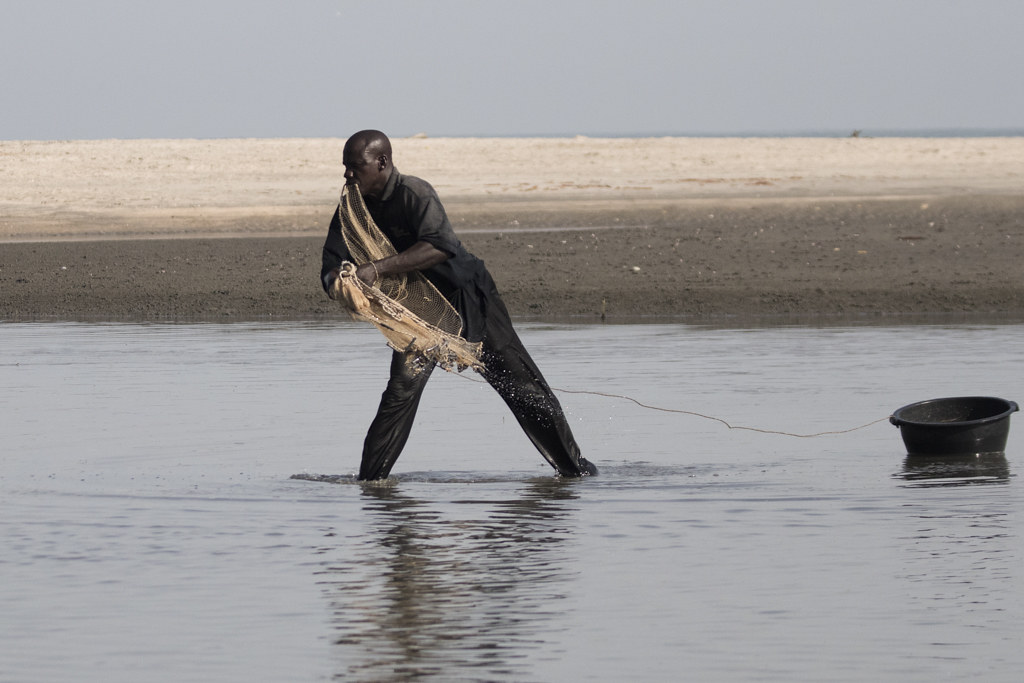
There were a couple of guys who regularly fished the creek.
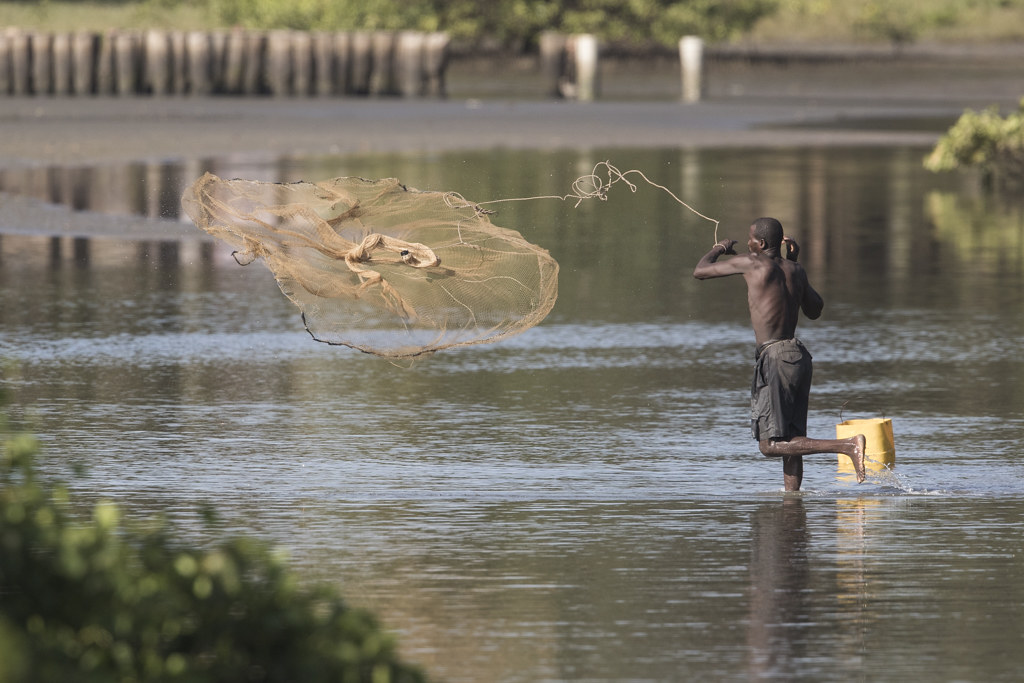
Very effective they were too although most of the fish caught using this method are pretty small.
No the Kingfishers I was after are the avian sort.
The stunning little Malachite to the previously seen Giant.
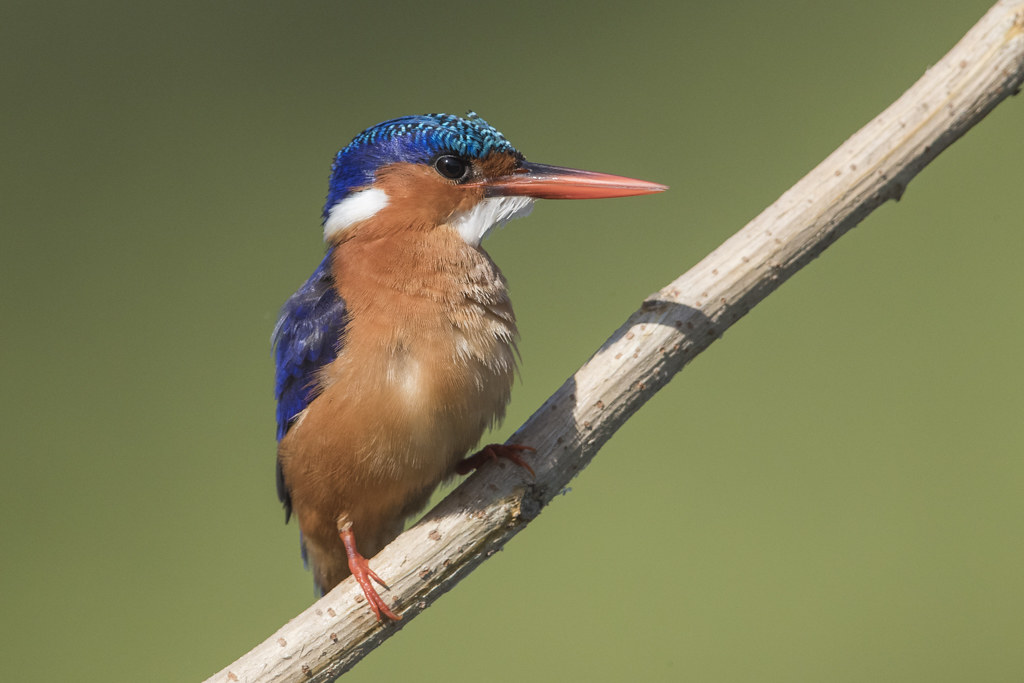
I didn't just want them sitting on a perch though, I was looking for some action.
Being bigger and somewhat slower the Giant proved easiest to catch as it came out of the water but I never witnessed it catch anything.
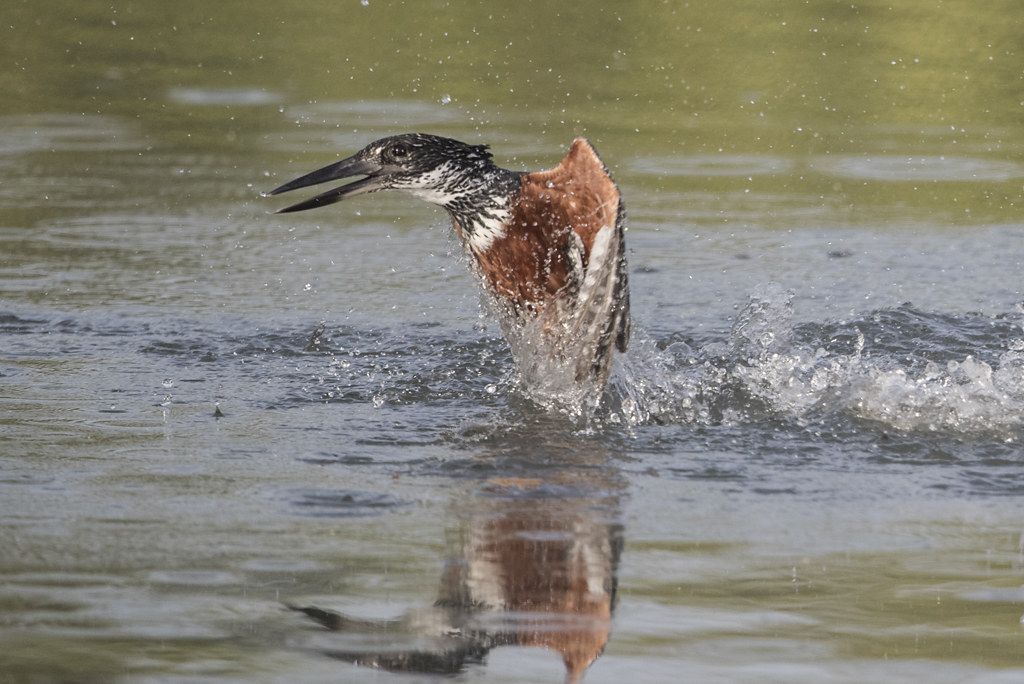
looked spectacular though!
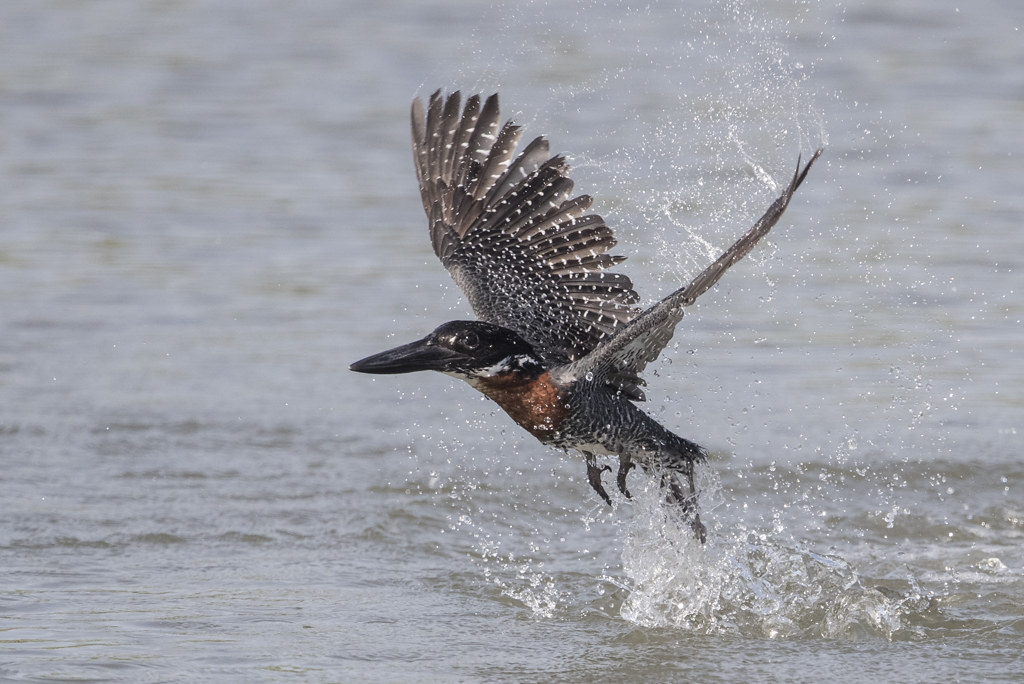
and it was easy "ish" to follow with a tripod mounted lens too.
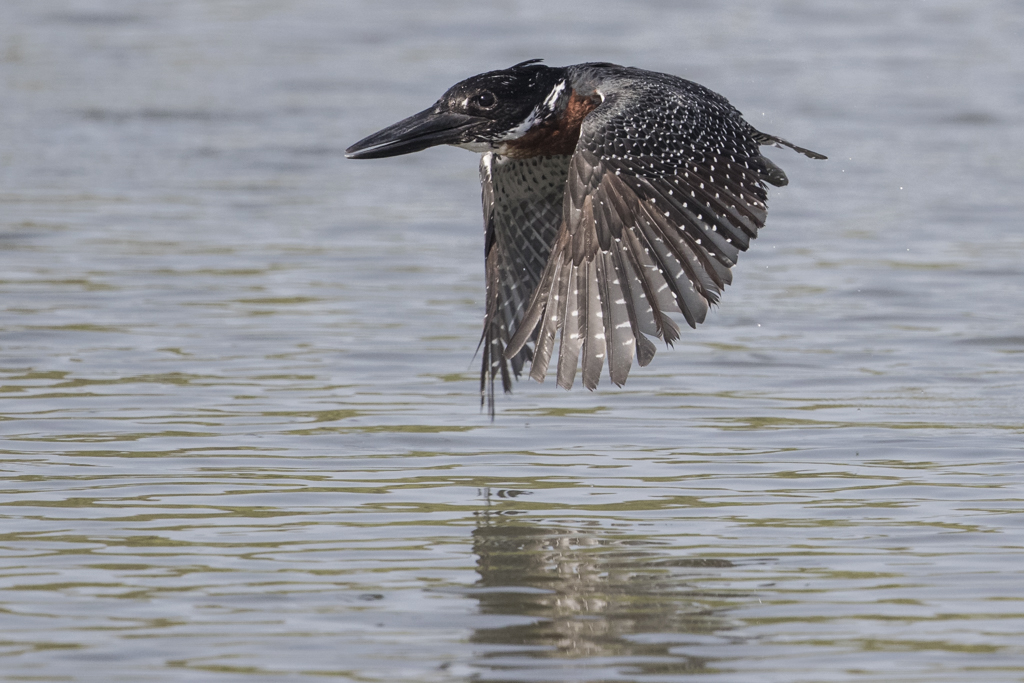
The Malachite on the other hand was unpredictable and quick and rarely gave an opportunity at all.
Being small there was the dilemma of using a teleconverter or not as that would make life even harder.
The full frame image looks like this.
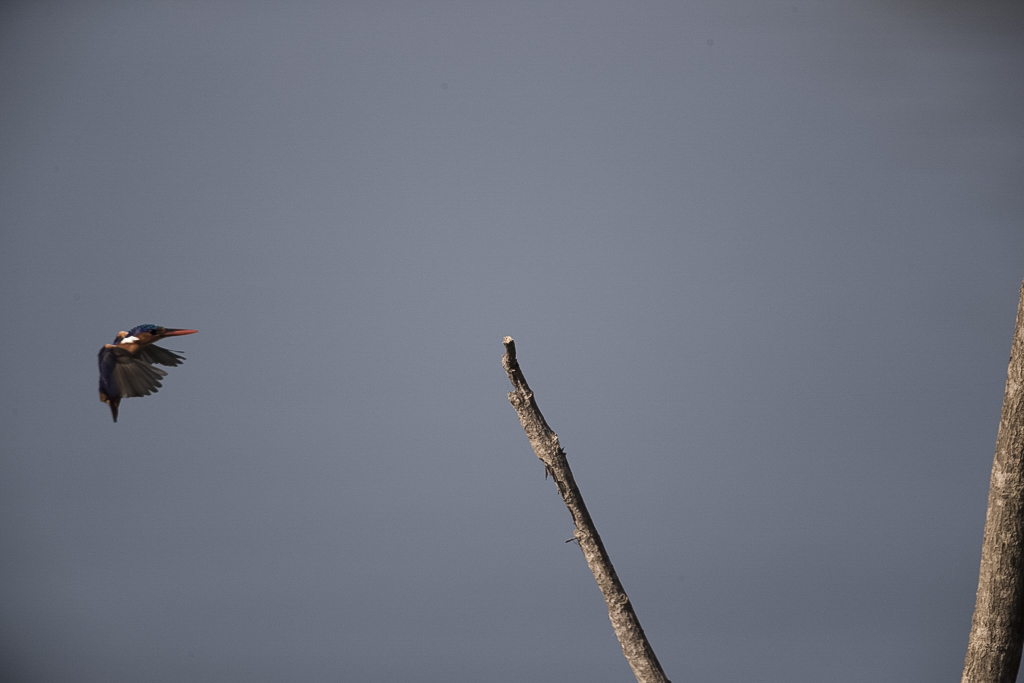
My preference is to focus on the perch and hope it lands on the one chosen.
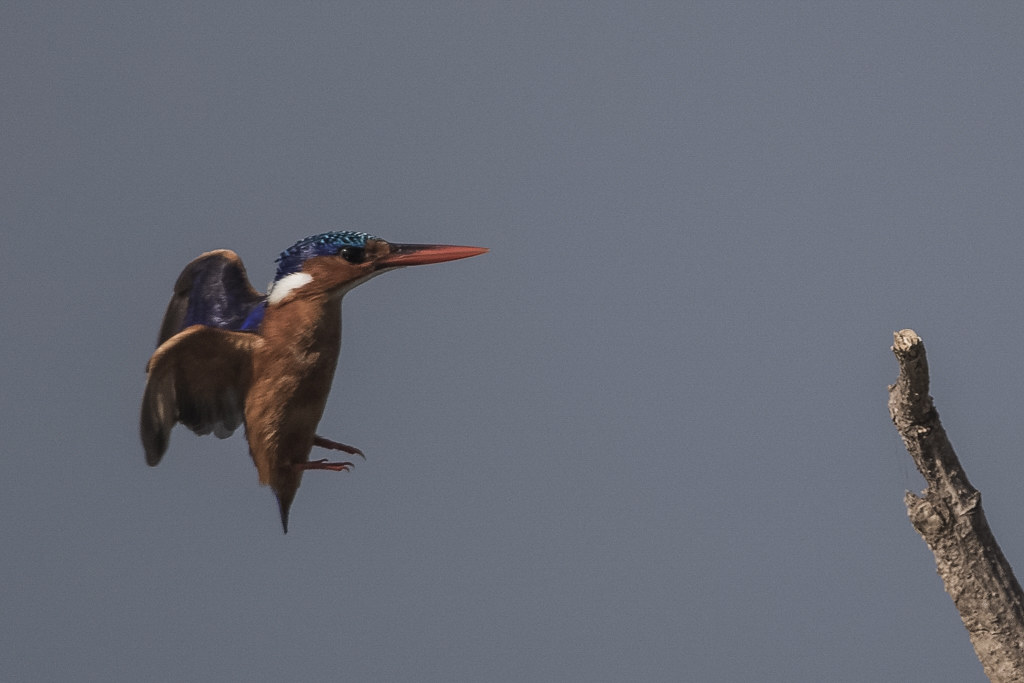
Too slow a shutter speed and you get motion blur
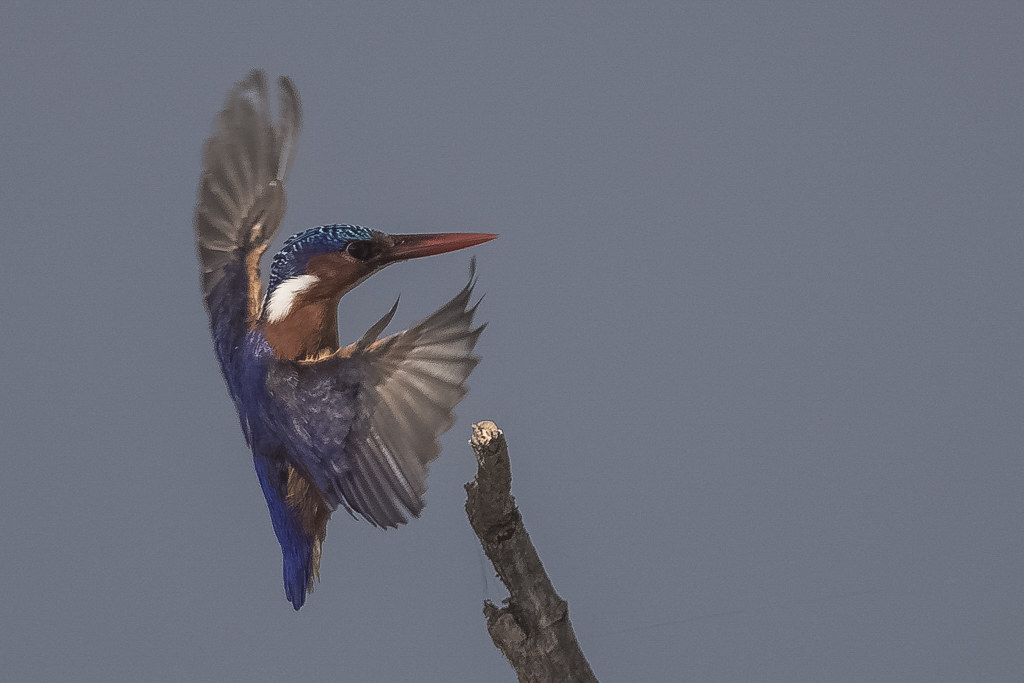
even at 1/4000th of a second shutter speed.
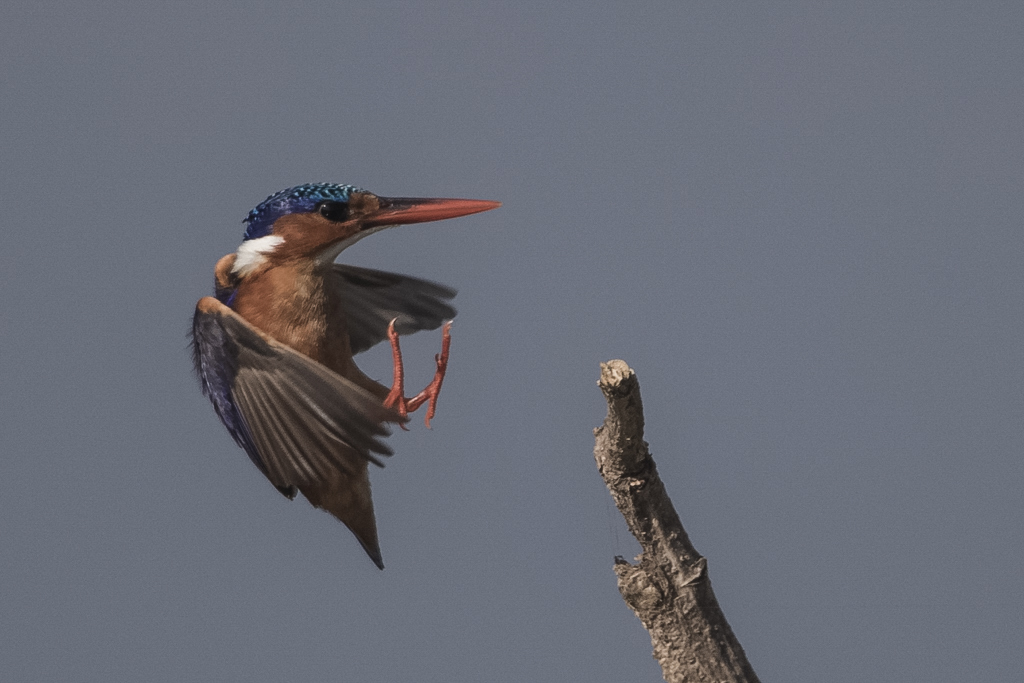
I never did get it right on the few occasions it performed for me!
My favoured place was from the bridge at Kotu, seen here at the top of the photo,
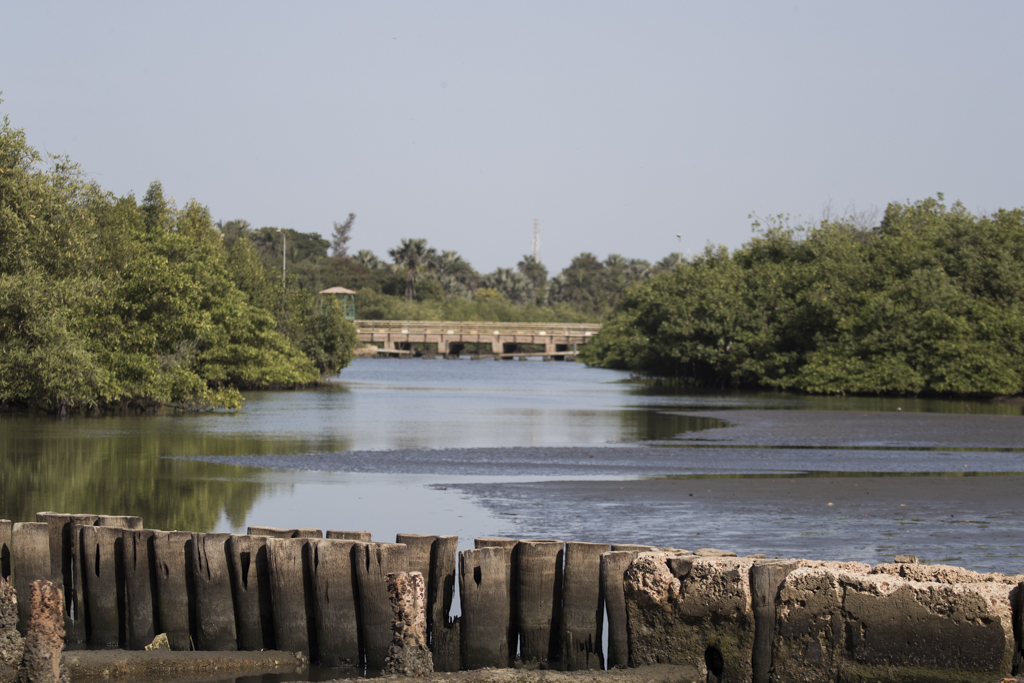
There were quite a few perches that had been put in place here. The bird guides claimed they had put them there and I'm sure they did, but I met someone who claimed they were his idea. Anyway, they were there to take advantage of! Just guess which one the bird would use!
Pied Kingfishers were present in fairly large numbers. They are very confiding often landing on the bridge railings or nearby bushes when there are people stood close by.
I wanted the classic landing pose though!
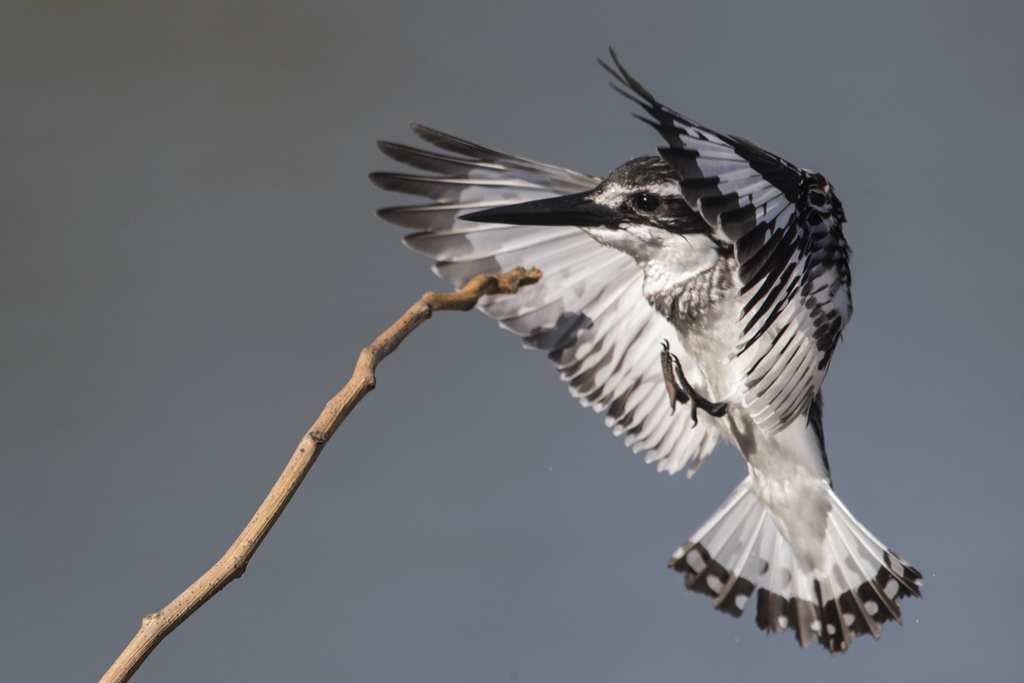
Not quite sharp and you only get one shot before it lands.
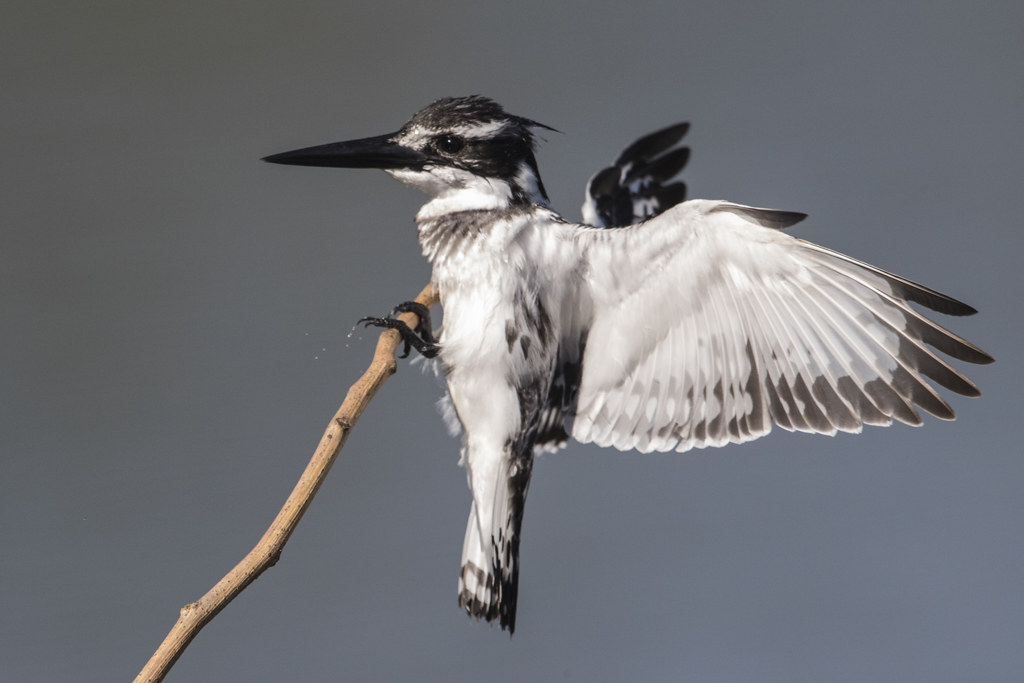
After several messed up attempts and many hours waiting I finally came up with something I was happy with.
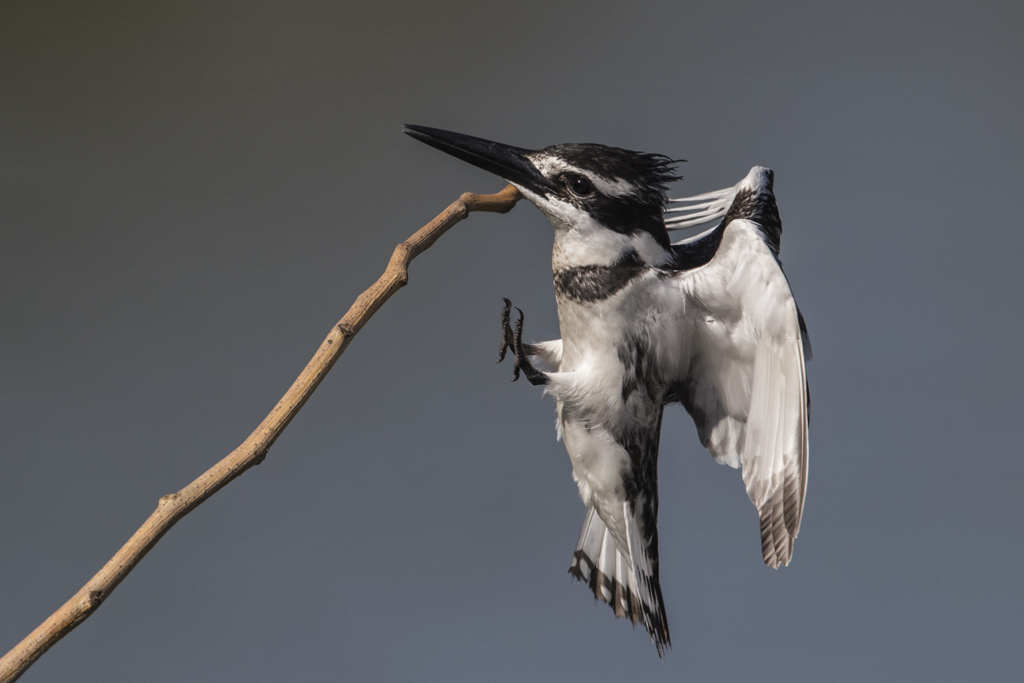
Looks pretty sharp
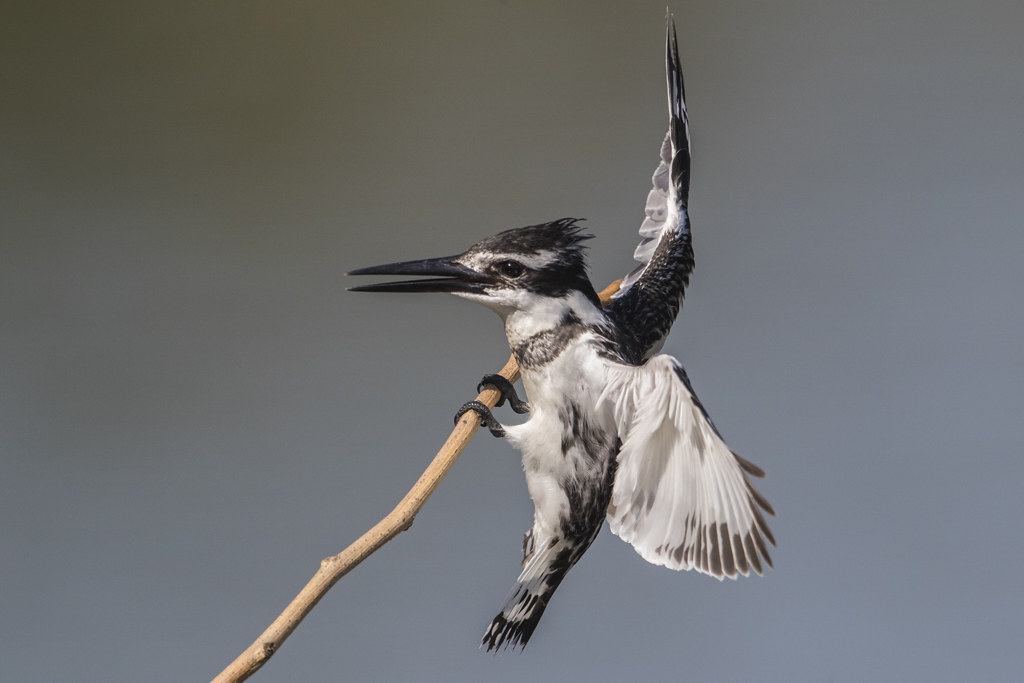
Exposures OK.
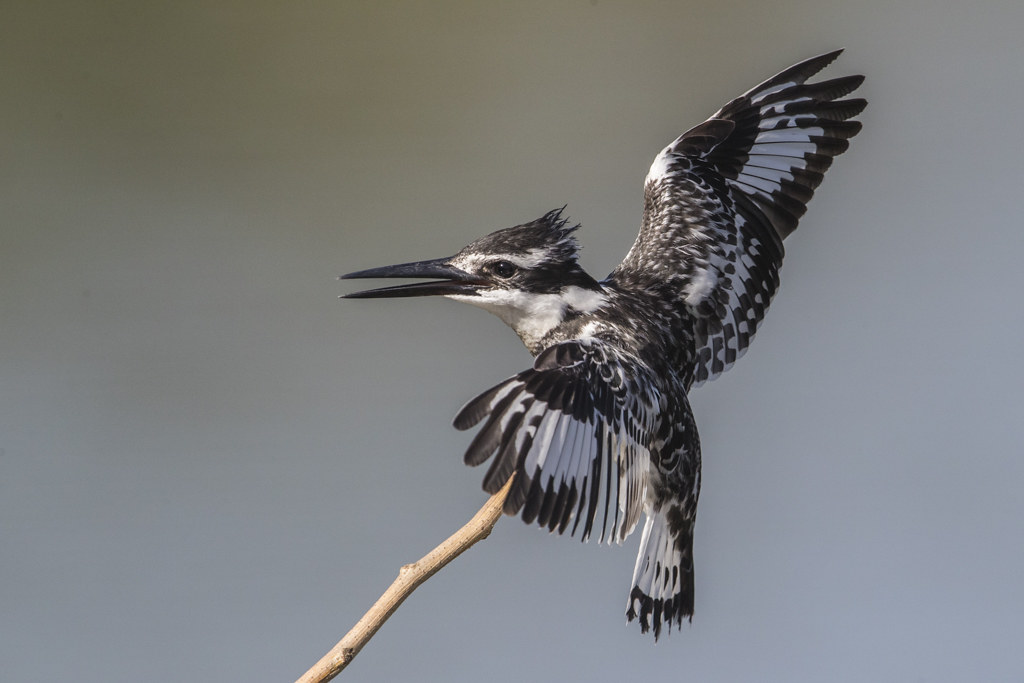
Nice wingspread.
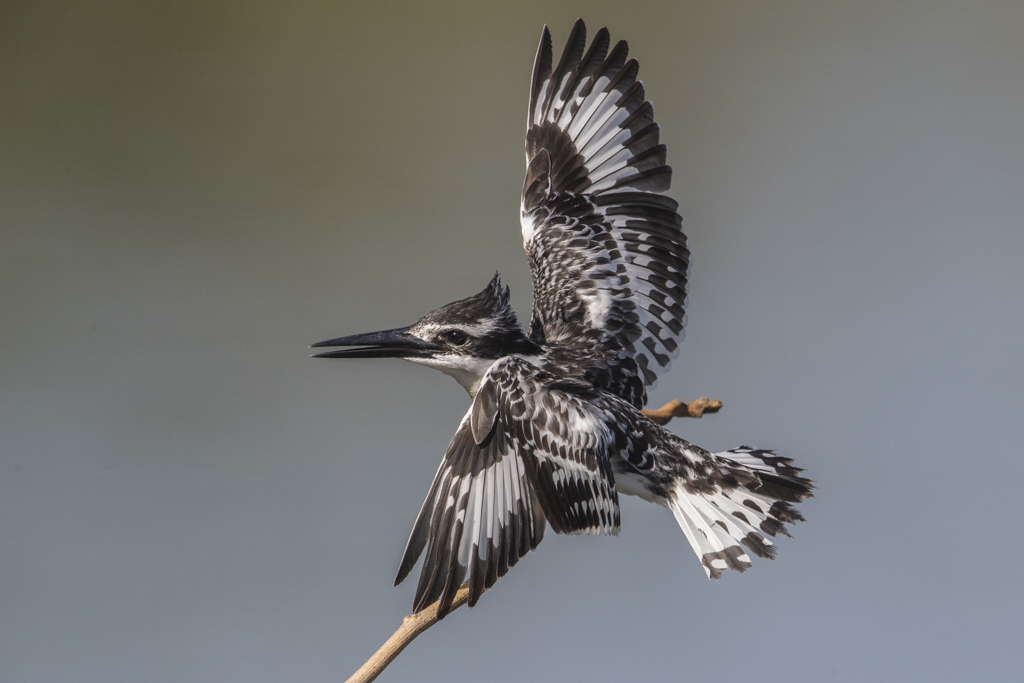
Very nice even!
I kept my finger on the shutter button as the bird settled
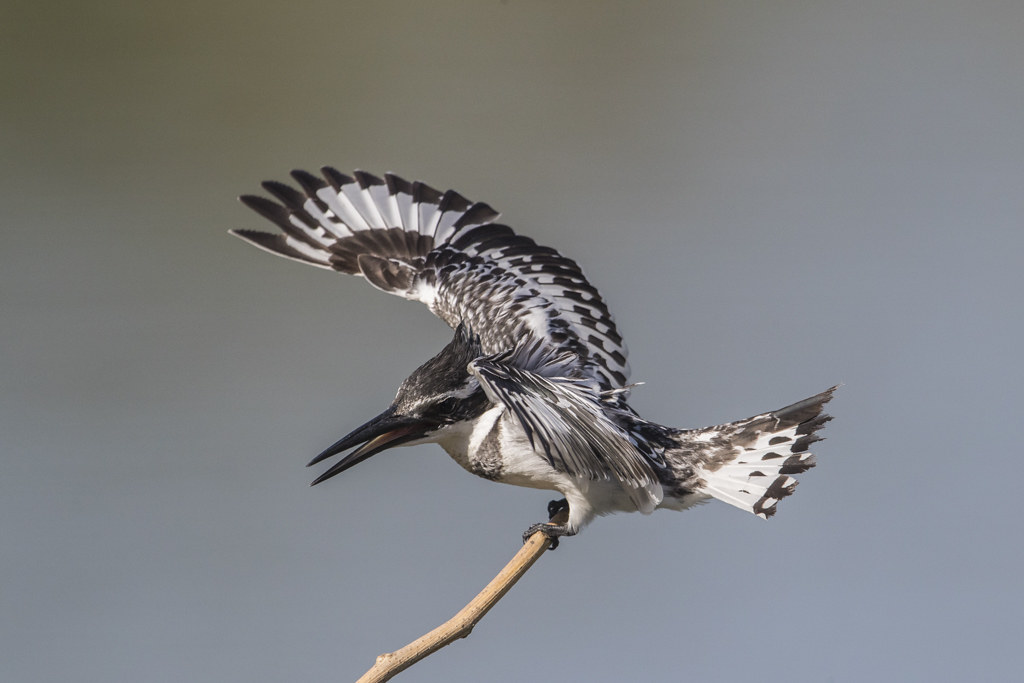
and it took a couple of more shots.
I ideally would use a remote control to take the pictures, that way when you suddenly grab at the camera there is no risk of it moving off the selected target and you can also watch the action as you take the photos without distractions.
Mine was left at home due to weight restrictions on the plane!
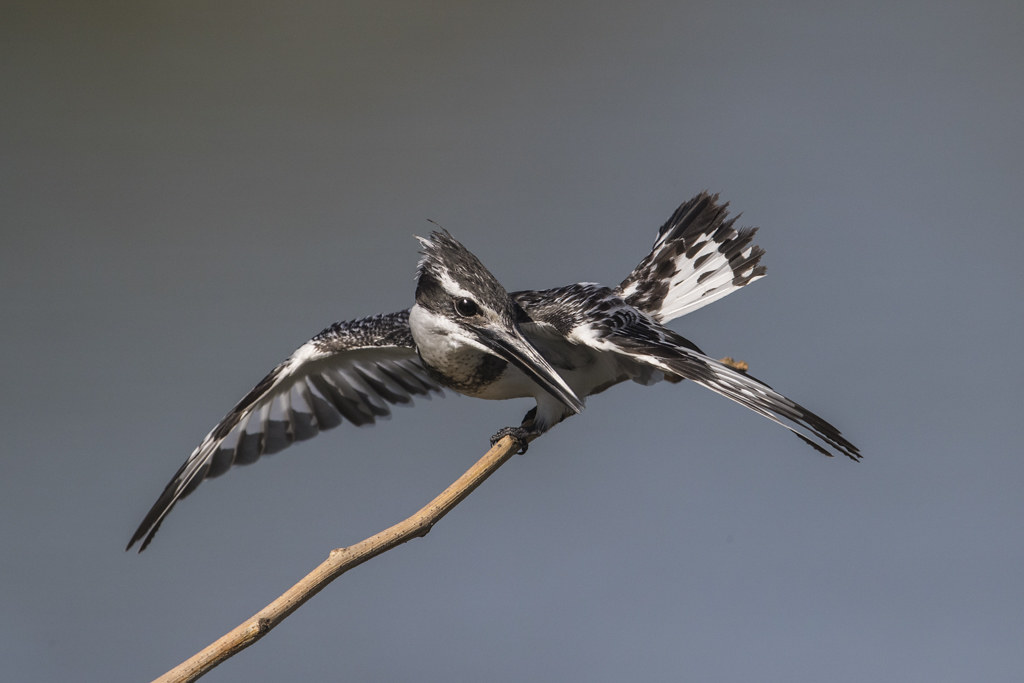
As I was taking the last few shots I realised there was more action to be had.
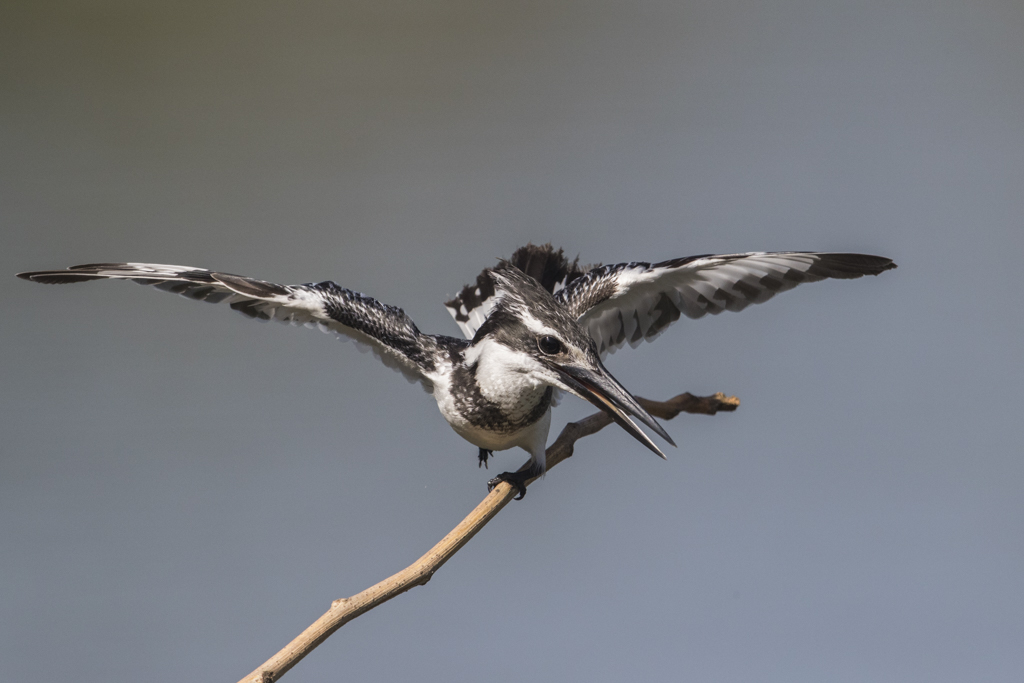
The bird swung around but I didn't catch this until I looked at the photos later.
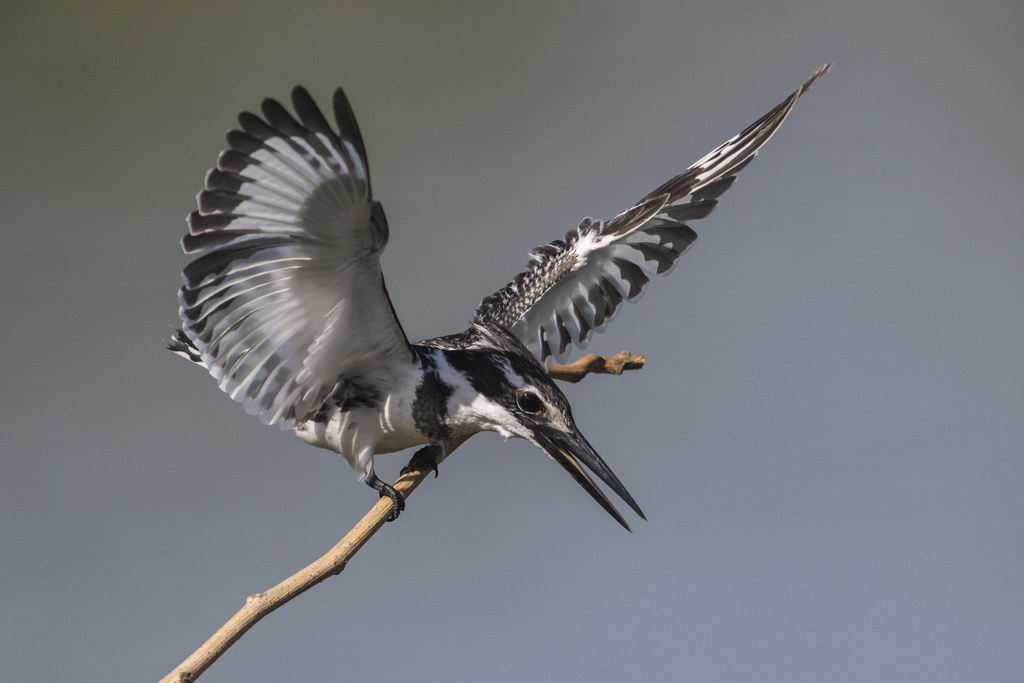
I heard a commotion though.
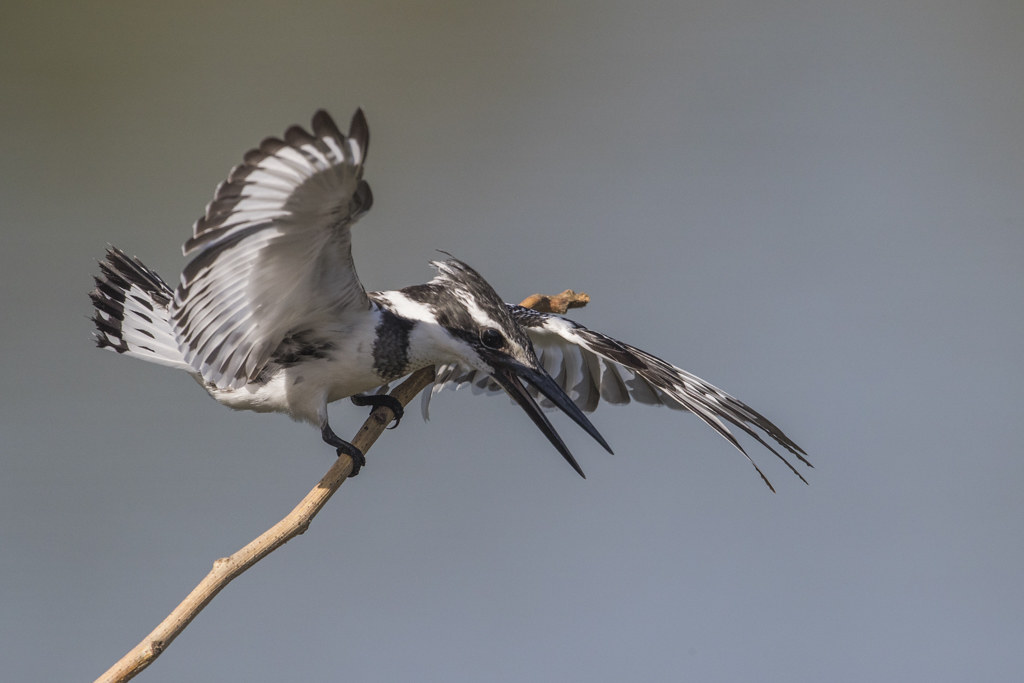
There was more than one bird involved!
Steady !
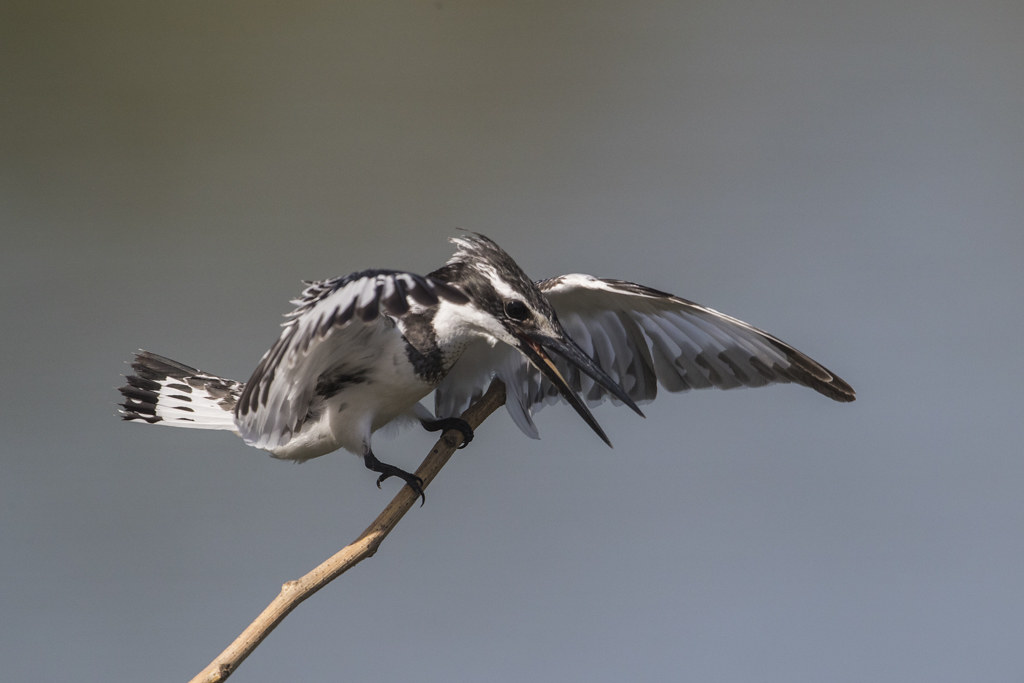
and as I released the shutter button I quickly depressed it again.
Just in time I caught the impact!
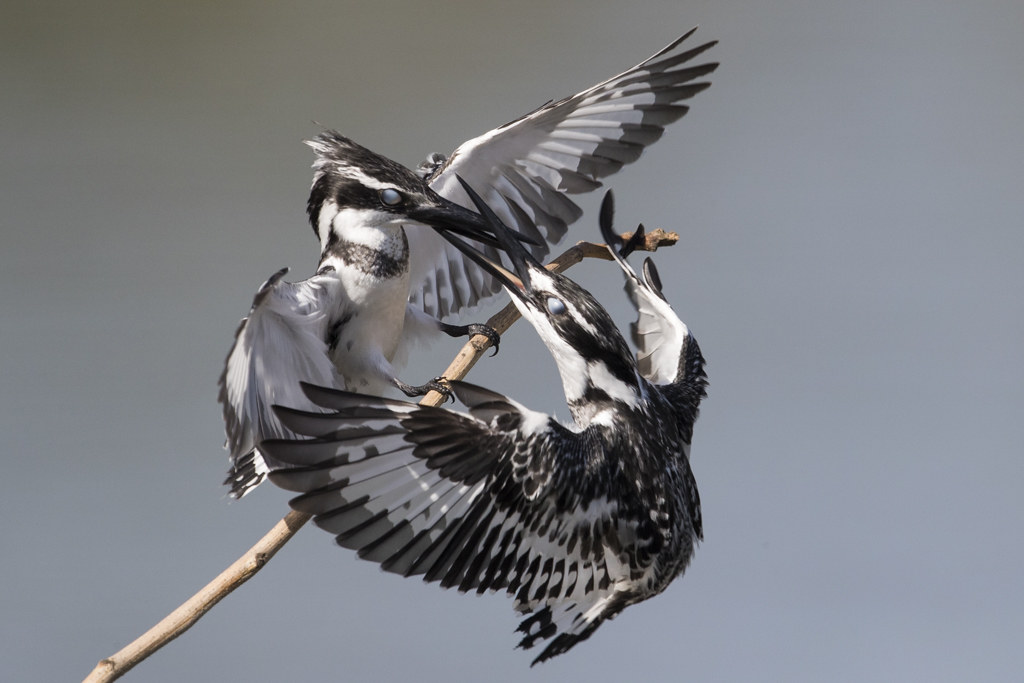
Bang! Take that !
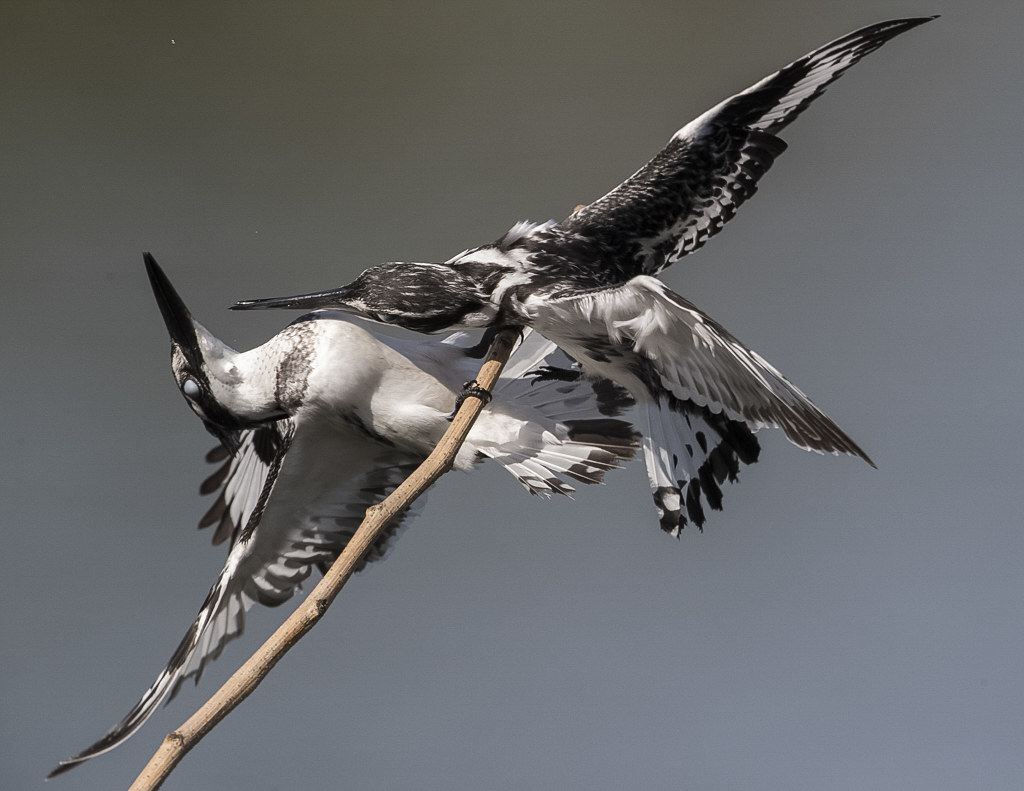
Quite literally knocked off it's perch and I had managed to capture it too.
Delighted with the result that would do me if I didn't get another picture of anything!
T.B.C.
One was the Painted Snipe, one of my favourite species! Sadly it was not to be despite my having put some effort in to finding one it appeared there was too much water at their known spot locally so that idea was abandoned eventually.
The other target was Kingfishers!
Now there are several kinds to be found, all skilful and none more so than the human kind!

There were a couple of guys who regularly fished the creek.

Very effective they were too although most of the fish caught using this method are pretty small.
No the Kingfishers I was after are the avian sort.
The stunning little Malachite to the previously seen Giant.

I didn't just want them sitting on a perch though, I was looking for some action.
Being bigger and somewhat slower the Giant proved easiest to catch as it came out of the water but I never witnessed it catch anything.

looked spectacular though!

and it was easy "ish" to follow with a tripod mounted lens too.

The Malachite on the other hand was unpredictable and quick and rarely gave an opportunity at all.
Being small there was the dilemma of using a teleconverter or not as that would make life even harder.
The full frame image looks like this.

My preference is to focus on the perch and hope it lands on the one chosen.

Too slow a shutter speed and you get motion blur

even at 1/4000th of a second shutter speed.

I never did get it right on the few occasions it performed for me!
My favoured place was from the bridge at Kotu, seen here at the top of the photo,

There were quite a few perches that had been put in place here. The bird guides claimed they had put them there and I'm sure they did, but I met someone who claimed they were his idea. Anyway, they were there to take advantage of! Just guess which one the bird would use!
Pied Kingfishers were present in fairly large numbers. They are very confiding often landing on the bridge railings or nearby bushes when there are people stood close by.
I wanted the classic landing pose though!

Not quite sharp and you only get one shot before it lands.

After several messed up attempts and many hours waiting I finally came up with something I was happy with.

Looks pretty sharp

Exposures OK.

Nice wingspread.

Very nice even!
I kept my finger on the shutter button as the bird settled

and it took a couple of more shots.
I ideally would use a remote control to take the pictures, that way when you suddenly grab at the camera there is no risk of it moving off the selected target and you can also watch the action as you take the photos without distractions.
Mine was left at home due to weight restrictions on the plane!

As I was taking the last few shots I realised there was more action to be had.

The bird swung around but I didn't catch this until I looked at the photos later.

I heard a commotion though.

There was more than one bird involved!
Steady !

and as I released the shutter button I quickly depressed it again.
Just in time I caught the impact!

Bang! Take that !

Quite literally knocked off it's perch and I had managed to capture it too.
Delighted with the result that would do me if I didn't get another picture of anything!
T.B.C.
Gambia 2016. Part 10. And now for something completely different!
Fortunately my inability to concentrate on reading a single book didn't matter especially as the internet reception was pretty good too. Catch up with the news, take a dip in the pool to cool down,exchange sightings with my new found birding mate Allan, yep two "L"'s in this one, and share general chat all around with him, his other half and a few others besides. Makes or breaks a holiday in my opinion and on this one we were lucky to have excellent company.
One of the problems of having a non birding partner is that the best light of the day co-incided with a) breakfast b) pre-dinorial drinks. What the heck, who cares, after a while you start to get a little birded out anyway.
My tactic became an hour or two in the morning until it became too hot then retreat until later in the afternoon for another hour or so until the need for a thirst quencher became to great to ignore. One of the big advantages of staying in one locality is that you begin to discover regular territories, perches and habits of the local residents and that's not just the birds either!
Sometimes I just got a bit lucky and would stumble across a bird like this Fine-spotted Woodpecker.
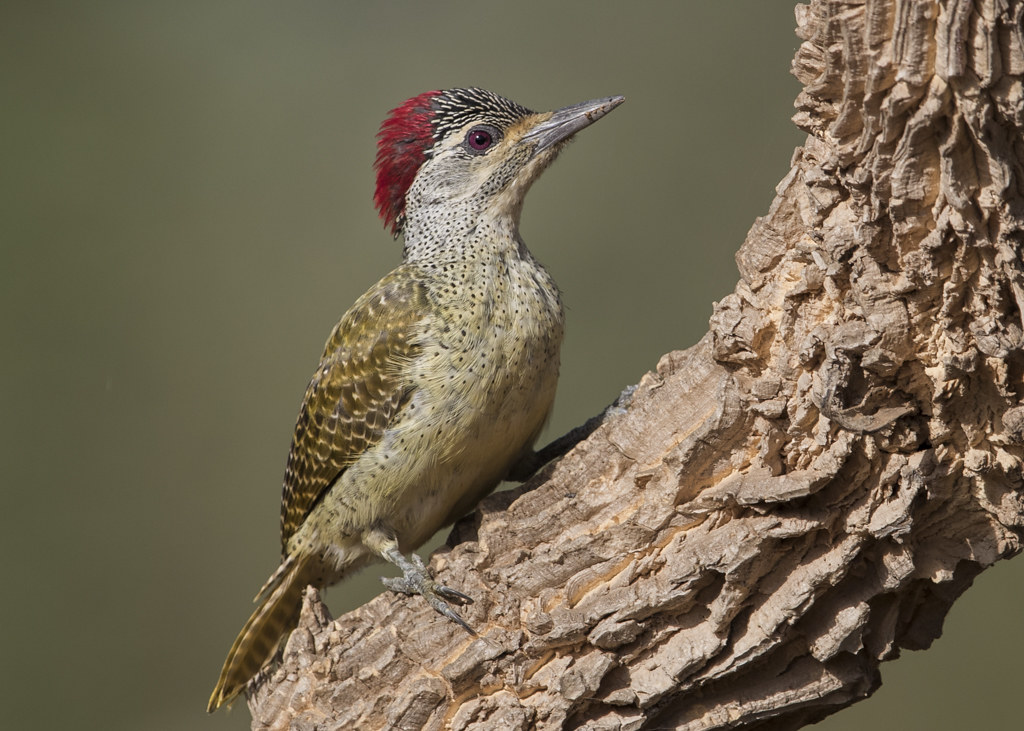
or the elusive Oriole Warbler
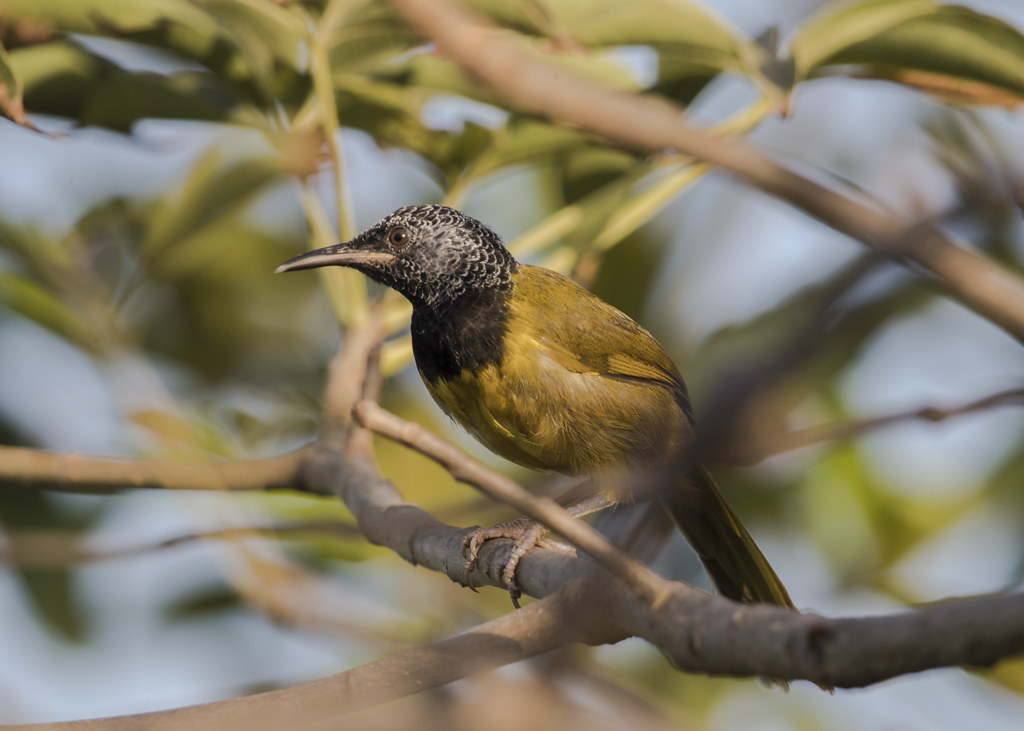
Sometimes the views were obscured and the best you could manage were a grab shot like that one.Sometimes you had plenty of time to try and capture a decent image.
A Yellow-billed Kite with a dead fish washed up on the beach.
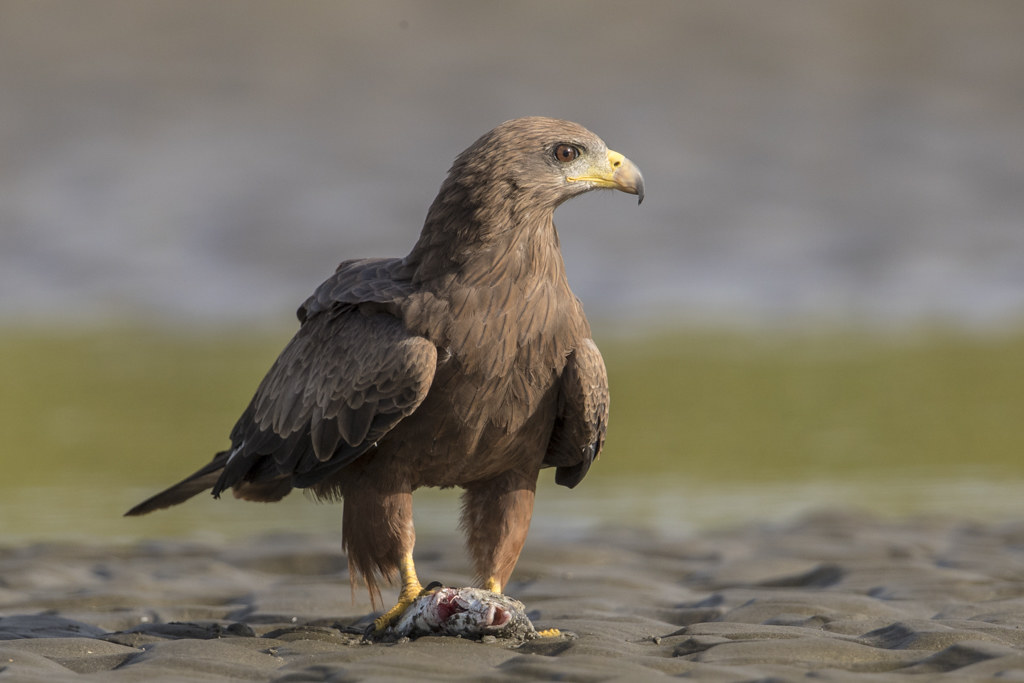
An easy meal for these carrion feeders.
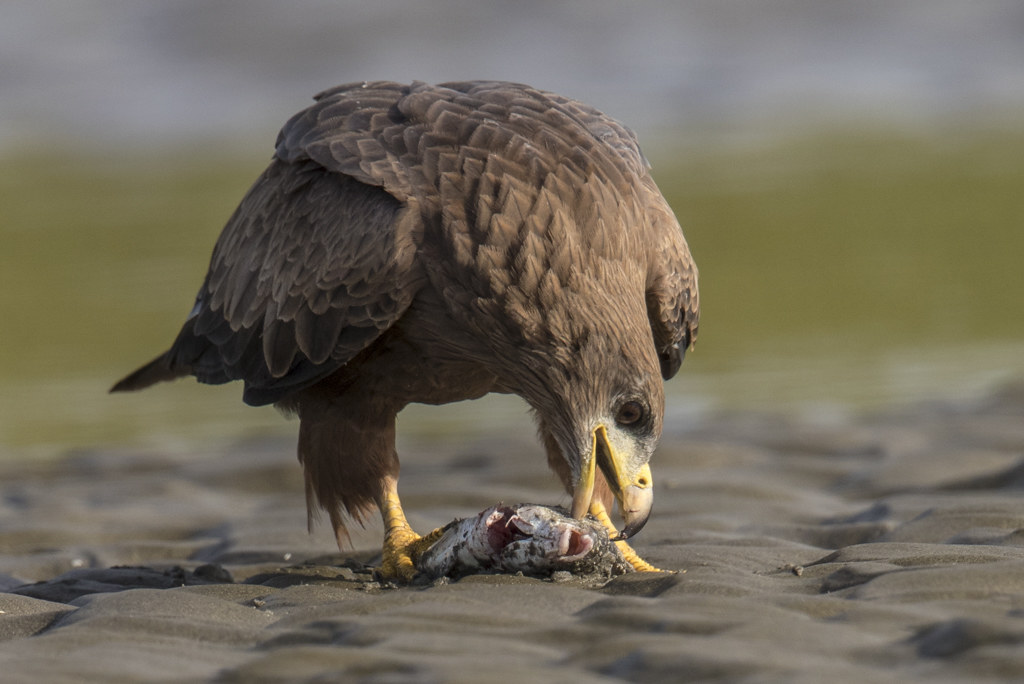
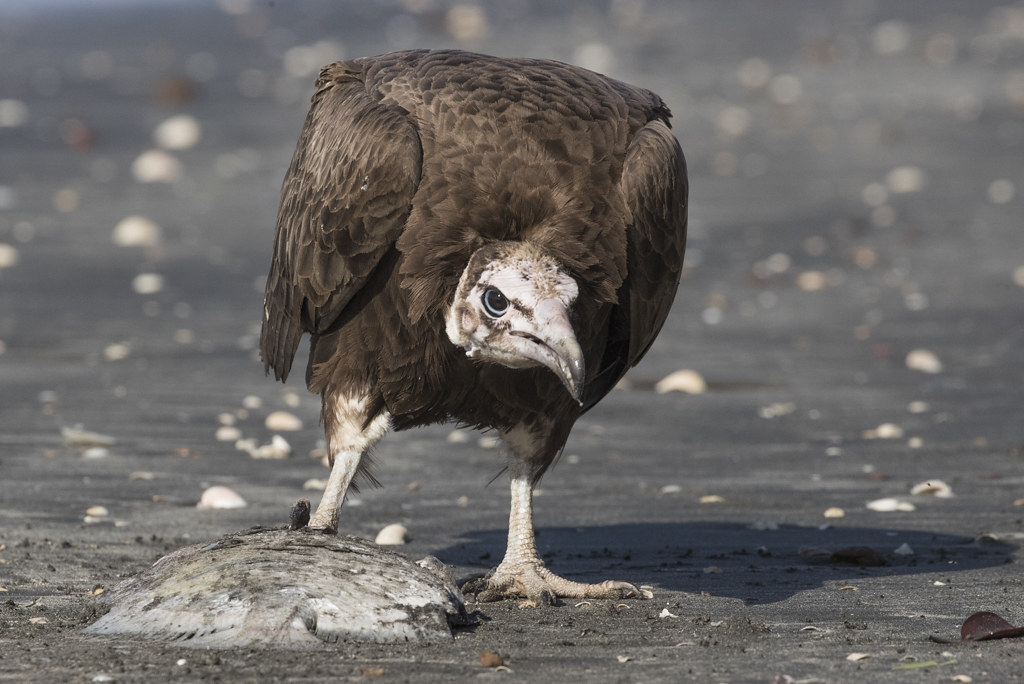
The Hooded Vulture wasn't quite having it all it's own way though and I witnessed some rather odd behaviour from a Pied Crow that joined it.
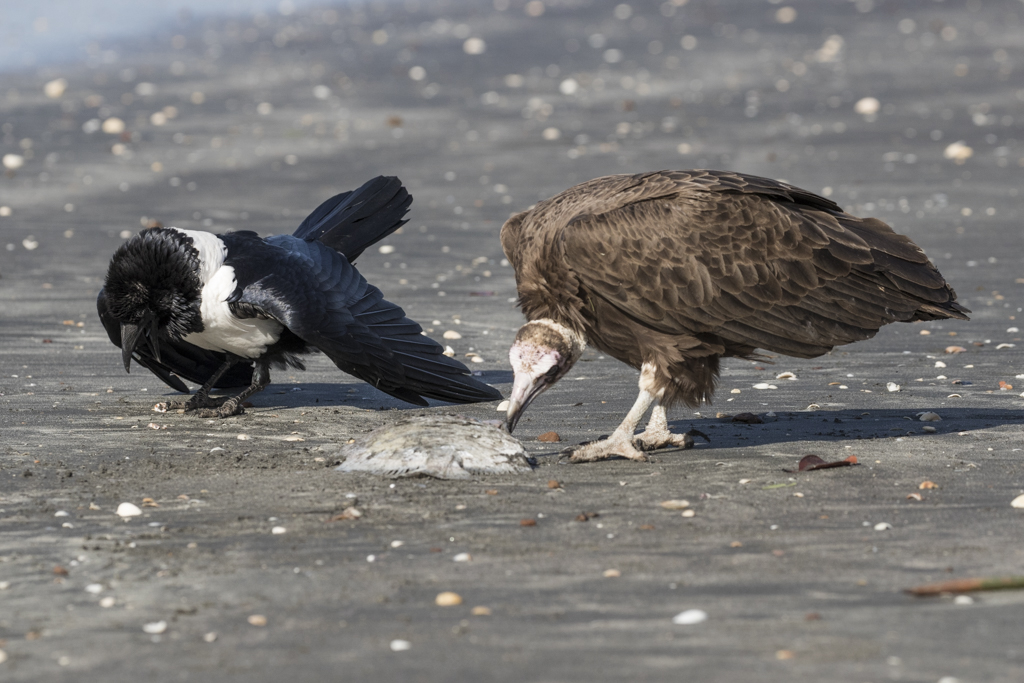
Initially it tried to distract the Vulture by tugging at it's tail feathers, then it came up alongside it and performed a weird display routine, a bit reminiscent of native American tribal dances.
Very interesting to watch and hear.
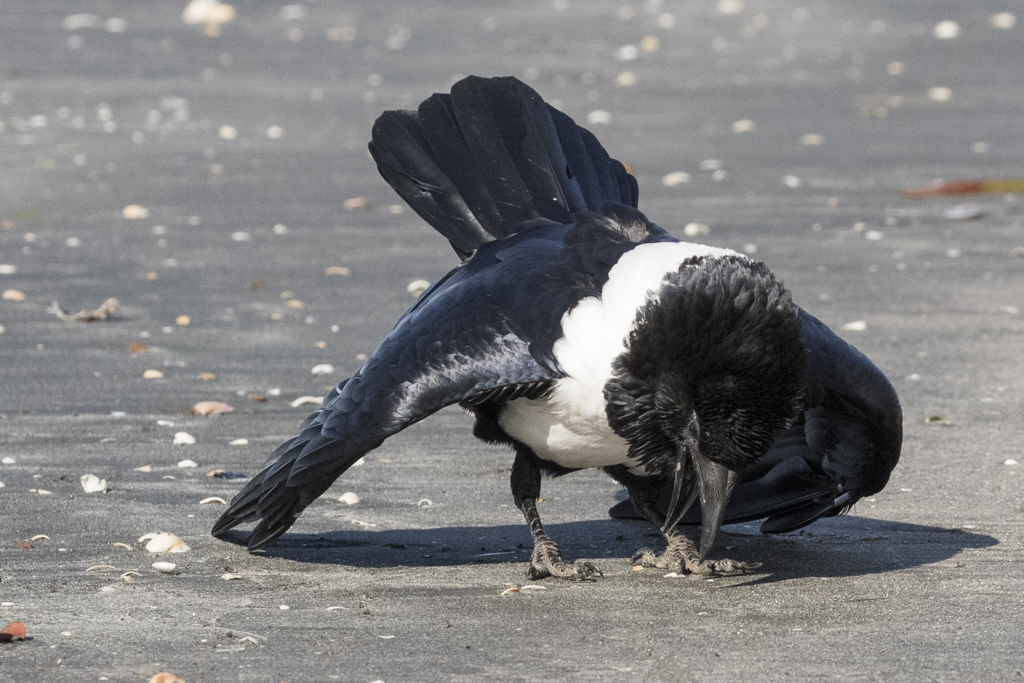
I'm not sure what the purpose was although before long it was joined by one or two more. Passing tourists flushed the lot in the end so there were no winners, just losers I guess.
Another regular on the waters edge down on the beach was the Western Reef Egret. Now I'd already seen plenty of fish catching action at the little pool I'd found.
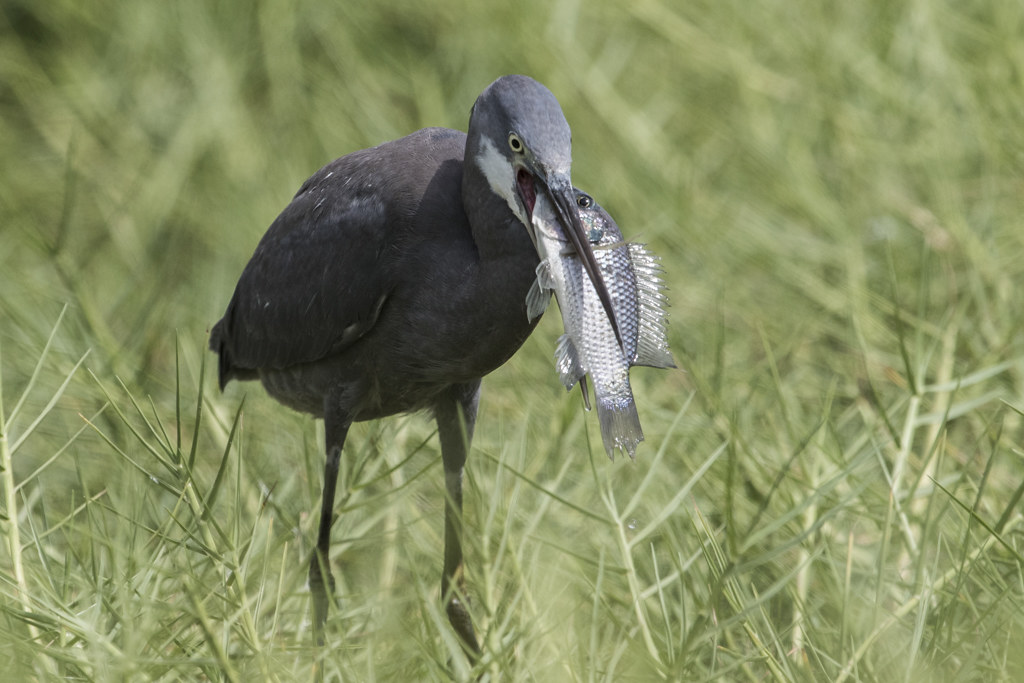
But now that was fished out we were back to having to work hard for a decent meal it seemed.
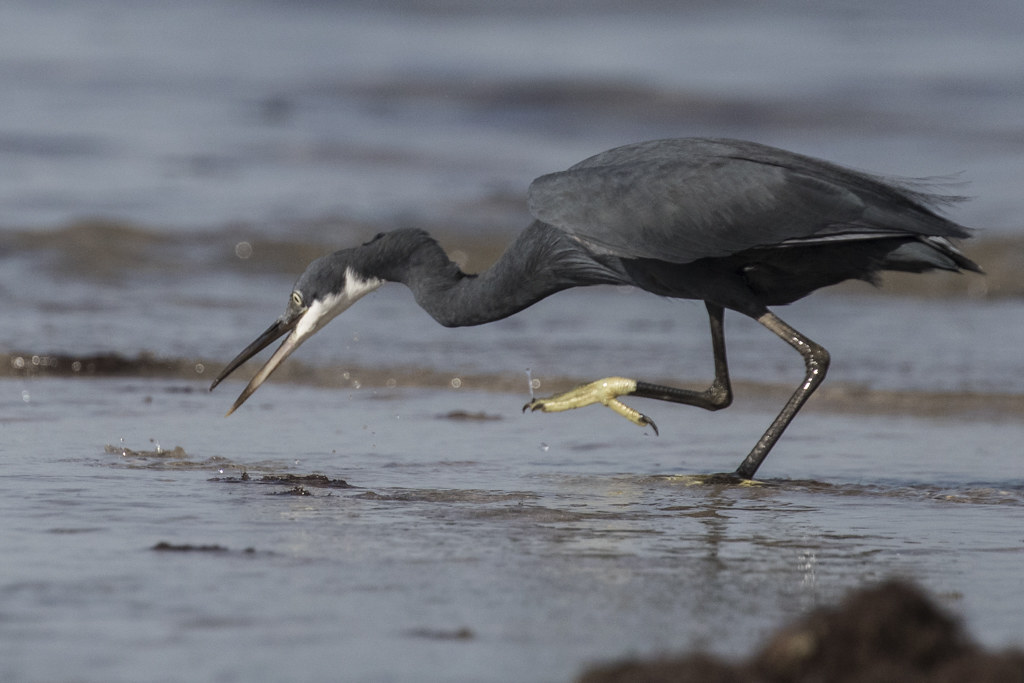
bit of a difference in calorie intake there.
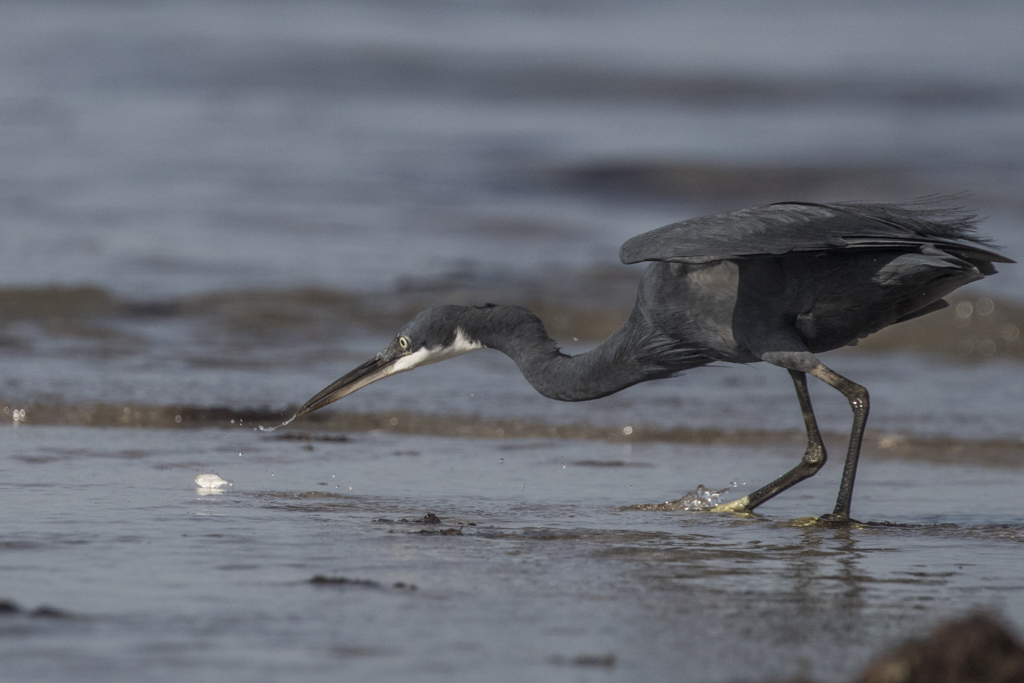
To be honest though the Reef Egret was something I had done to death on a previous visit so it didn't grab my imagination too much although a walk along the beach is very pleasant. In fact the beach is quite superb really, huge expanses with not too many people
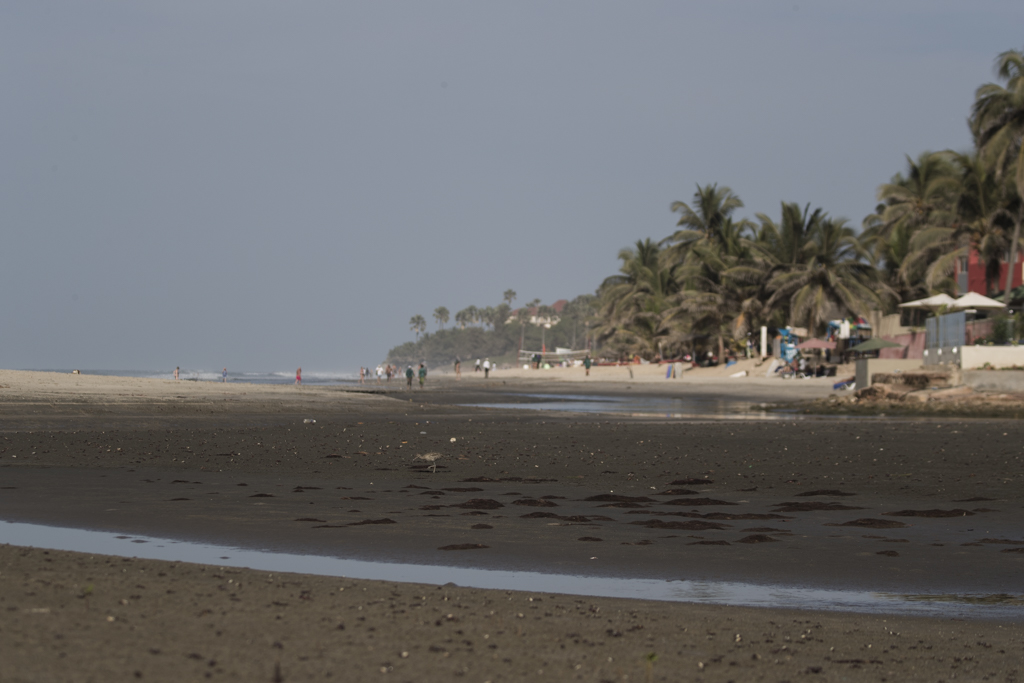
and with a half hour walk you can reach the more touristy Kololi area and the Senegambia hotel which used to be the birders favourite. Not sure that is still the case but the hotel grounds still hold a reasonable number of birds and is one of the best places to photograph the White-crowned Robin-chat where they seem to have increased in numbers since my last visit.
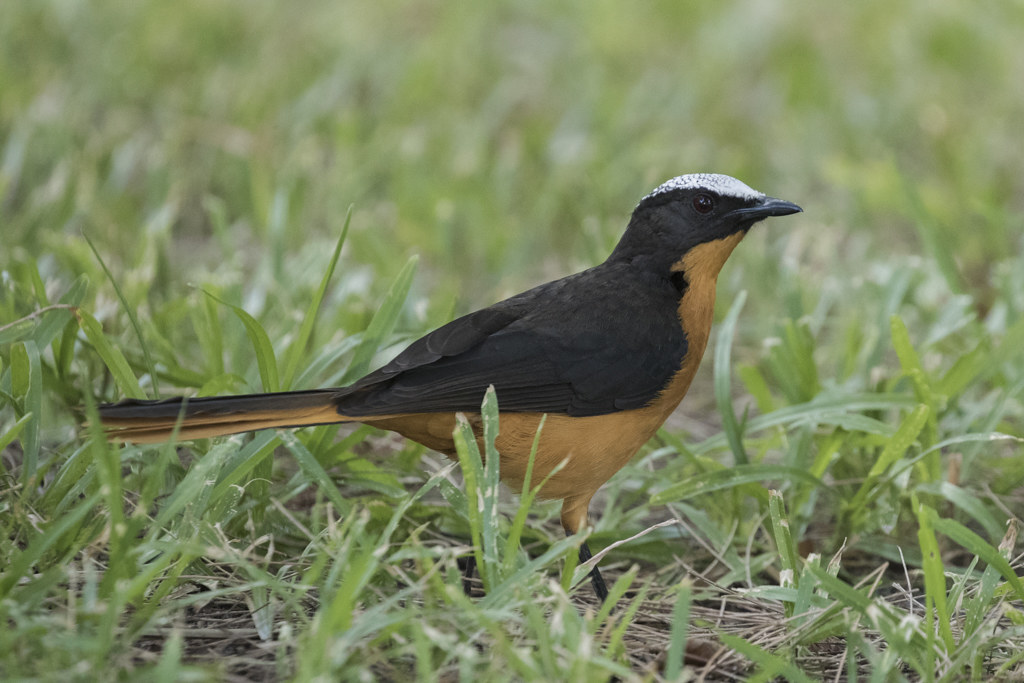
The other bird that regularly frequents the beach is the Whimbrel but that too doesn't have that much appeal as a photo challenge as it's another "been there, done that" when it comes to watching them catch crabs. This one was actually on the estuary rather than the beach.
Grab your crab by it's main attack weapon.
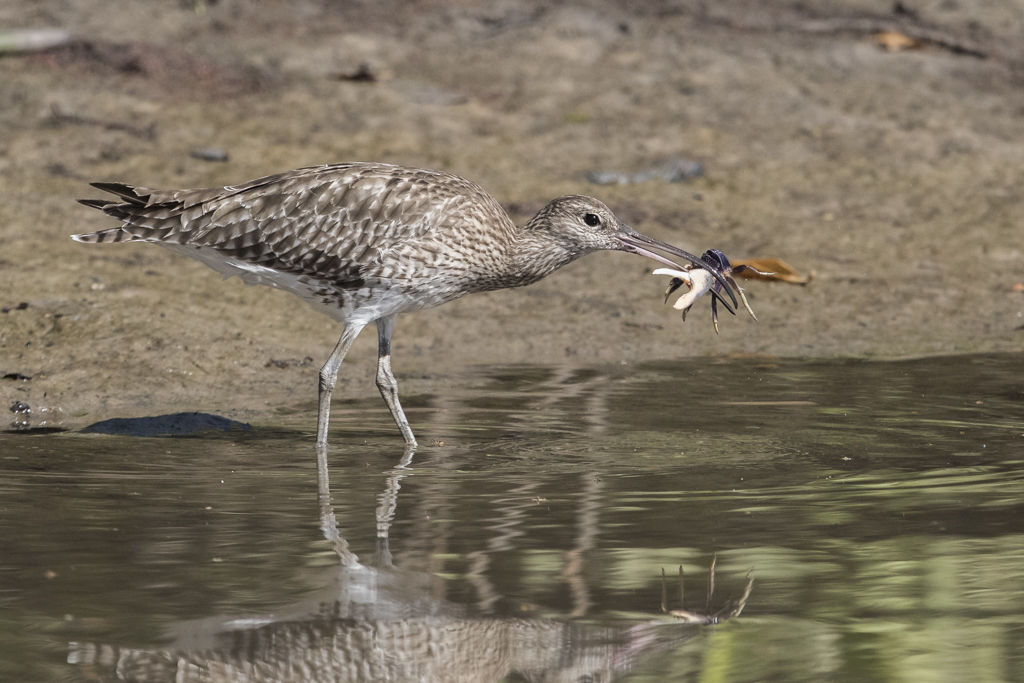
Then disarm it , literally, by shaking it violently until the body separates from the limb. The action is repeated in the most brutal and unpleasant death that is imaginable until the poor crab becomes a mere shell ready for swallowing.
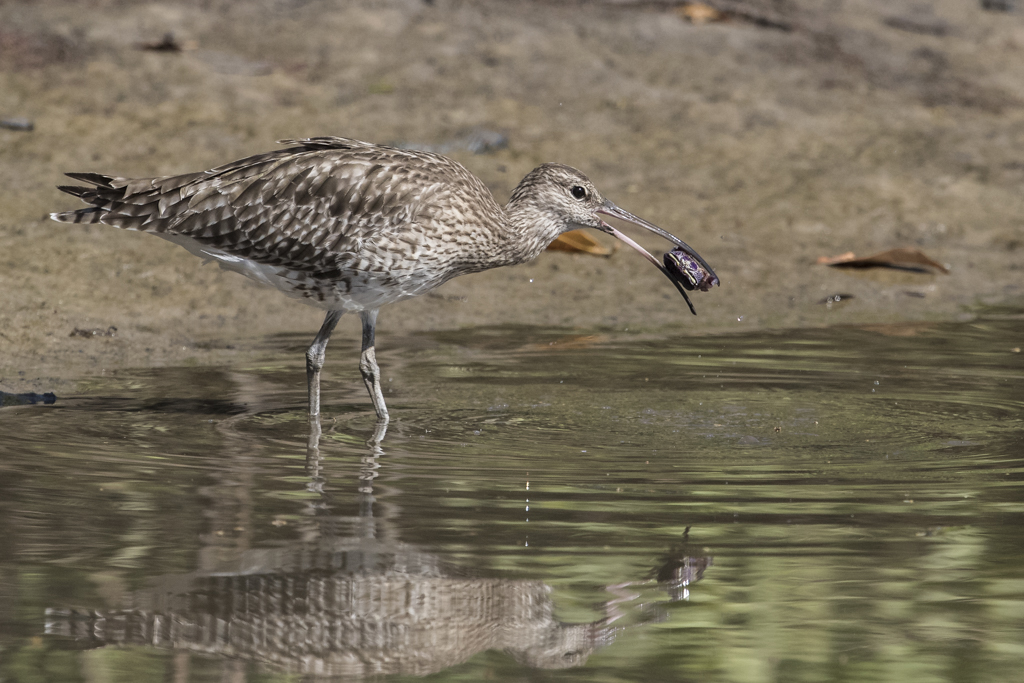
That action was found near to where you can cross over from the golf course at the top end of the creek too.
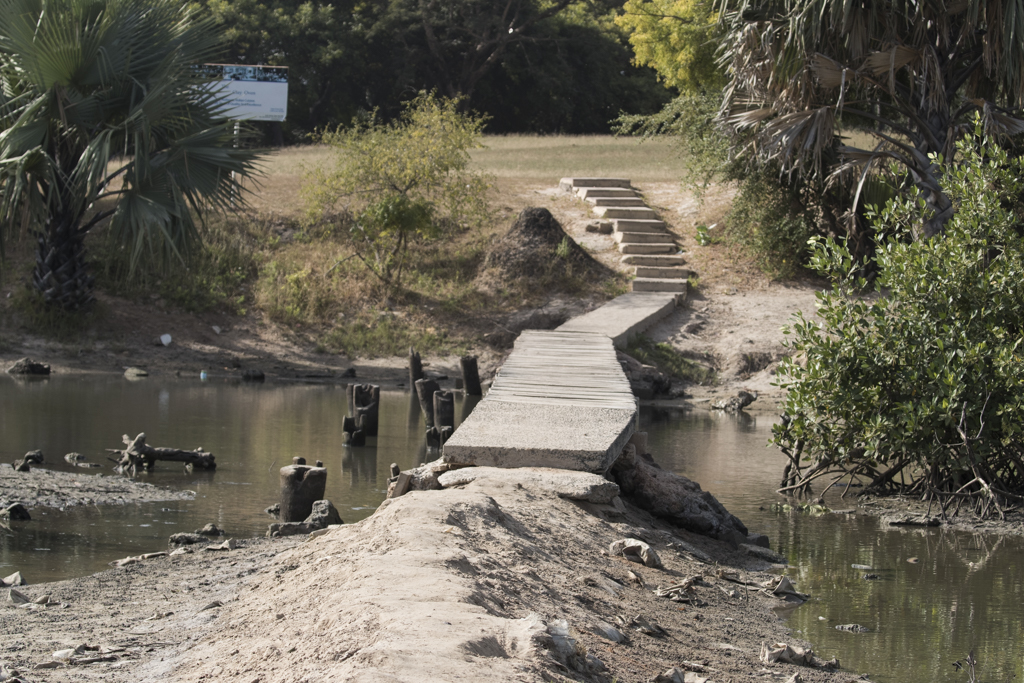
To my delight I discovered it was one of the Giant Kingfisher's haunts, depending on the state of the tide.
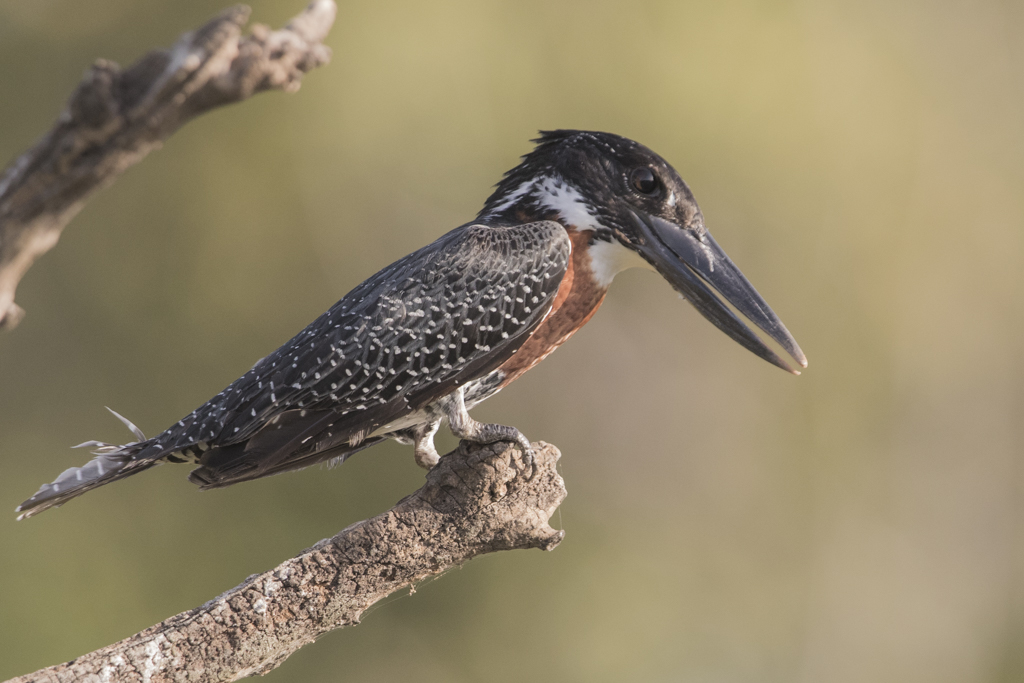
I tried on several occasions and got lucky on a couple with great views on a natural perch.
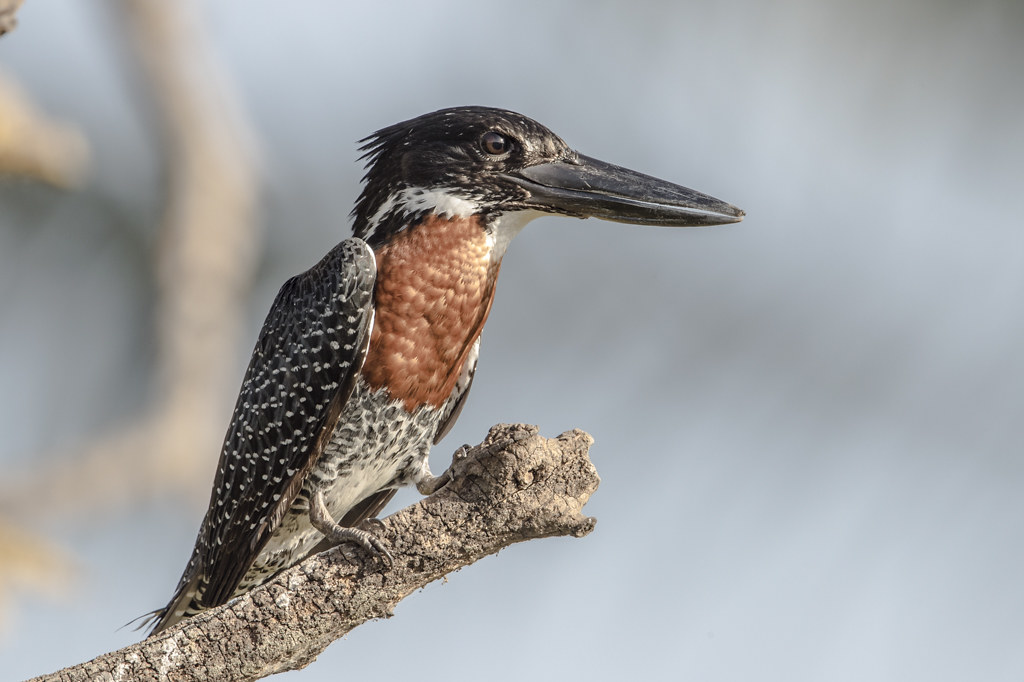
Sometimes I hung around for nothing, sometimes something different used the same tree.

The African Grey Hornbill in display mode ! Easier to catch standing still.
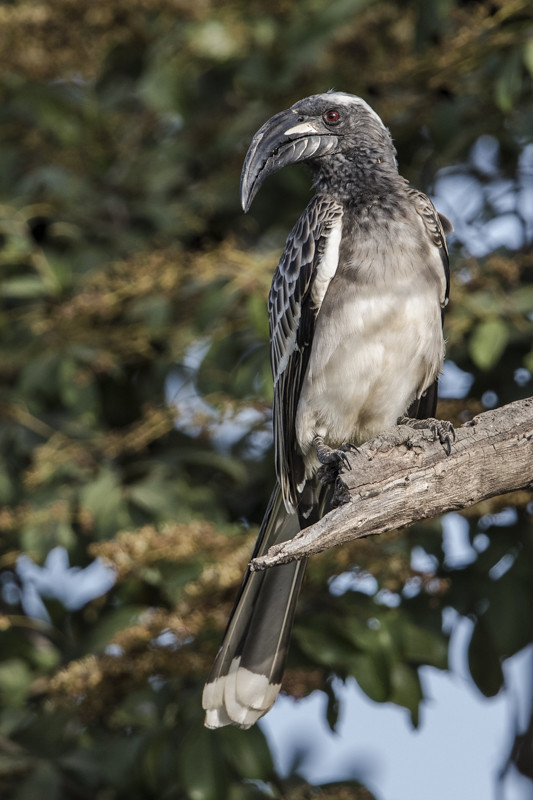
but much easier than trying to capture fast flying Little Swifts.
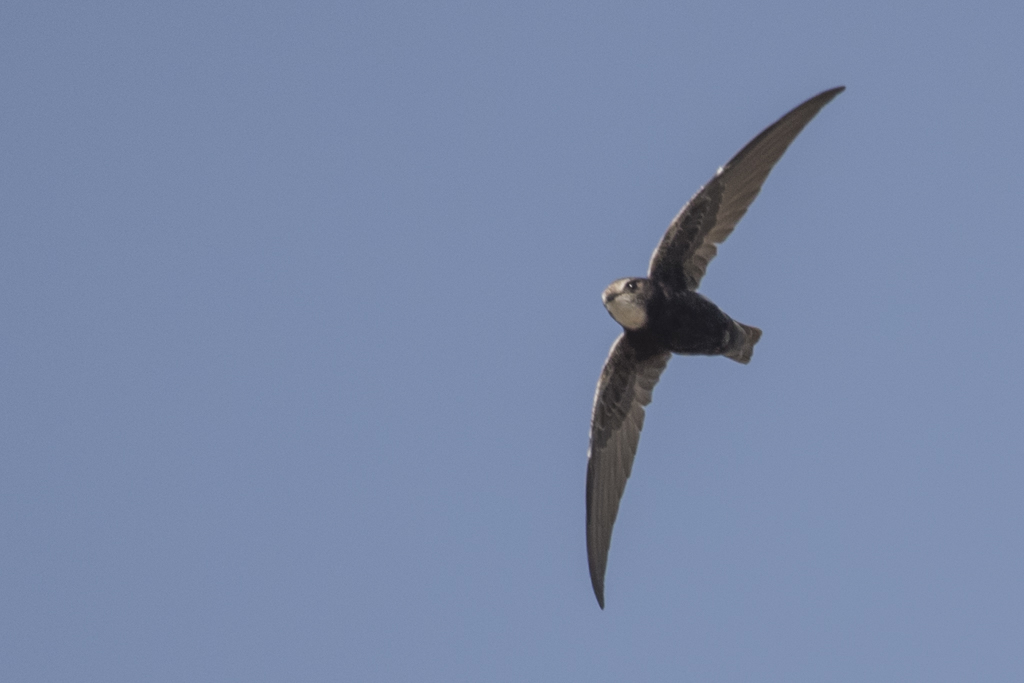
or African Palm Swifts.
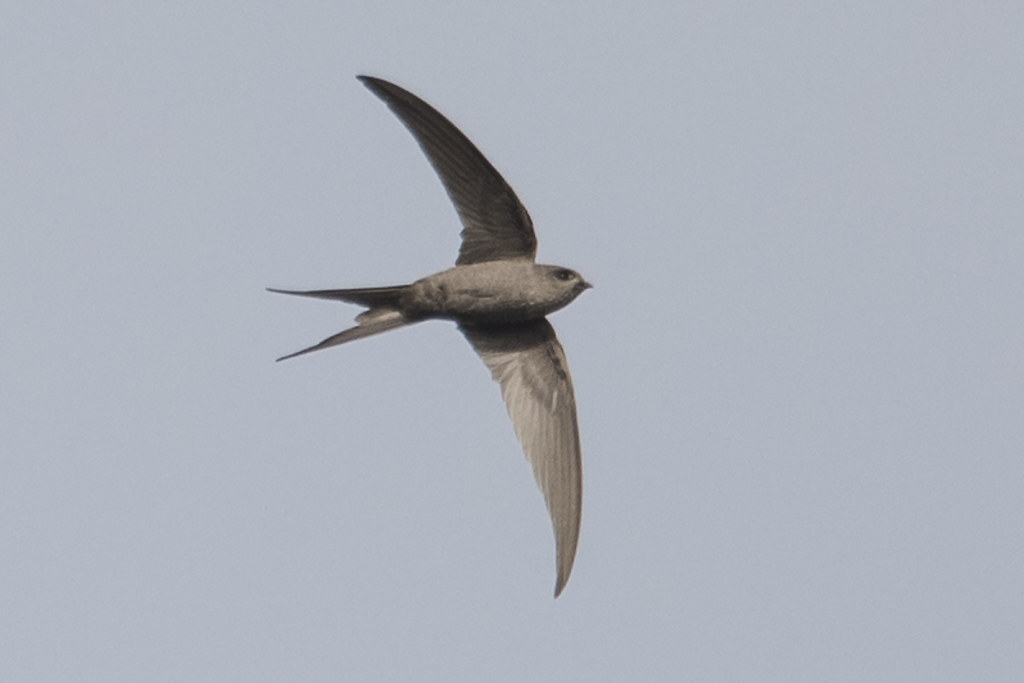
Hand holding my 600mm lens isn't that easy. Combined with trying to find your subject in the view finder it's a bit of a nightmare. I have a 500mm lens that is much easier to use but that had been left at home this time.
No, I'd brought the 600mm with two specific targets in mind and that was what I'd concentrate on doing.
T.BC.
One of the problems of having a non birding partner is that the best light of the day co-incided with a) breakfast b) pre-dinorial drinks. What the heck, who cares, after a while you start to get a little birded out anyway.
My tactic became an hour or two in the morning until it became too hot then retreat until later in the afternoon for another hour or so until the need for a thirst quencher became to great to ignore. One of the big advantages of staying in one locality is that you begin to discover regular territories, perches and habits of the local residents and that's not just the birds either!
Sometimes I just got a bit lucky and would stumble across a bird like this Fine-spotted Woodpecker.

or the elusive Oriole Warbler

Sometimes the views were obscured and the best you could manage were a grab shot like that one.Sometimes you had plenty of time to try and capture a decent image.
A Yellow-billed Kite with a dead fish washed up on the beach.

An easy meal for these carrion feeders.


The Hooded Vulture wasn't quite having it all it's own way though and I witnessed some rather odd behaviour from a Pied Crow that joined it.

Initially it tried to distract the Vulture by tugging at it's tail feathers, then it came up alongside it and performed a weird display routine, a bit reminiscent of native American tribal dances.
Very interesting to watch and hear.

I'm not sure what the purpose was although before long it was joined by one or two more. Passing tourists flushed the lot in the end so there were no winners, just losers I guess.
Another regular on the waters edge down on the beach was the Western Reef Egret. Now I'd already seen plenty of fish catching action at the little pool I'd found.

But now that was fished out we were back to having to work hard for a decent meal it seemed.

bit of a difference in calorie intake there.

To be honest though the Reef Egret was something I had done to death on a previous visit so it didn't grab my imagination too much although a walk along the beach is very pleasant. In fact the beach is quite superb really, huge expanses with not too many people

and with a half hour walk you can reach the more touristy Kololi area and the Senegambia hotel which used to be the birders favourite. Not sure that is still the case but the hotel grounds still hold a reasonable number of birds and is one of the best places to photograph the White-crowned Robin-chat where they seem to have increased in numbers since my last visit.

The other bird that regularly frequents the beach is the Whimbrel but that too doesn't have that much appeal as a photo challenge as it's another "been there, done that" when it comes to watching them catch crabs. This one was actually on the estuary rather than the beach.
Grab your crab by it's main attack weapon.

Then disarm it , literally, by shaking it violently until the body separates from the limb. The action is repeated in the most brutal and unpleasant death that is imaginable until the poor crab becomes a mere shell ready for swallowing.

That action was found near to where you can cross over from the golf course at the top end of the creek too.

To my delight I discovered it was one of the Giant Kingfisher's haunts, depending on the state of the tide.

I tried on several occasions and got lucky on a couple with great views on a natural perch.

Sometimes I hung around for nothing, sometimes something different used the same tree.

The African Grey Hornbill in display mode ! Easier to catch standing still.

but much easier than trying to capture fast flying Little Swifts.

or African Palm Swifts.

Hand holding my 600mm lens isn't that easy. Combined with trying to find your subject in the view finder it's a bit of a nightmare. I have a 500mm lens that is much easier to use but that had been left at home this time.
No, I'd brought the 600mm with two specific targets in mind and that was what I'd concentrate on doing.
T.BC.
Monday, 19 December 2016
Gambia 2016. Part 9. Back again!
It was slightly strange returning after a mere 10 days at home but good to know that wife Claire would be getting some sunshine to appease my guilt for leaving her behind on the first trip. Alan meanwhile was off to Goa and much though I enjoyed his company, and given a choice, dinner under the stars is preferable with my wife. I can't even tell you what colour Alan's eyes are!
I did have some slight doubts though. I had decided in advance that I would not be going to the extra expense of more guided trips, my budget was blown and this was a trip for Claire not me. The doubt was wether there was enough birding activity to keep me entertained for 2 weeks in and around the hotel. Lying by the pool all day is a non starter for me.
Fortunately I soon discovered a small pool, more a wet patch of ground really. Being near the river creek at Kotu this area floods during the wet season and as the flooding recedes it leaves behind one or two wet patches. I noticed that there was a huge amount of birding activity in this particular one which measured no more than a few square metres and was no more than ankle deep in water.
What was being pulled out was amazing! The fish were unbelievably big!
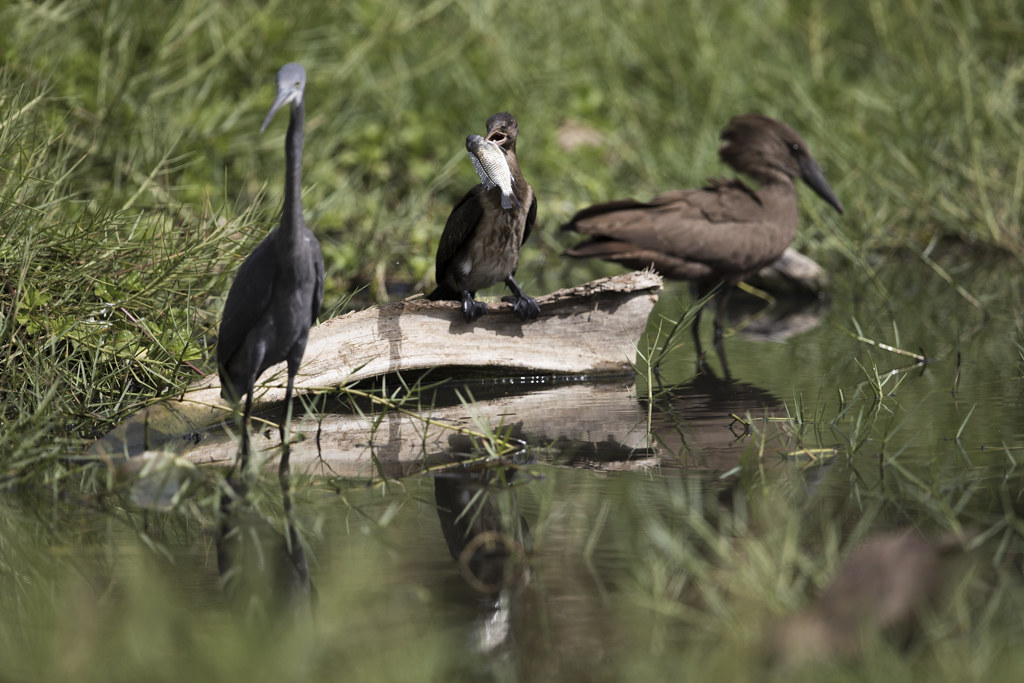
The Cormorant couldn't submerge fully and still caught a large fish. At least a dozen birds covering several species were sharing the same small space.
And every one was catching fish!
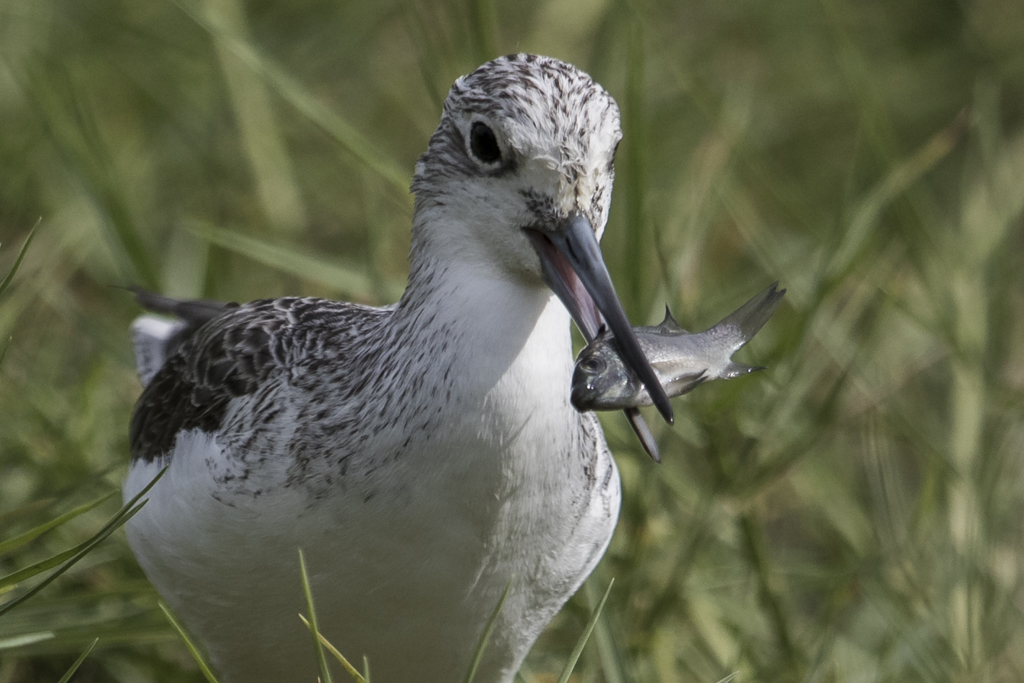
From Greenshank to Black Heron
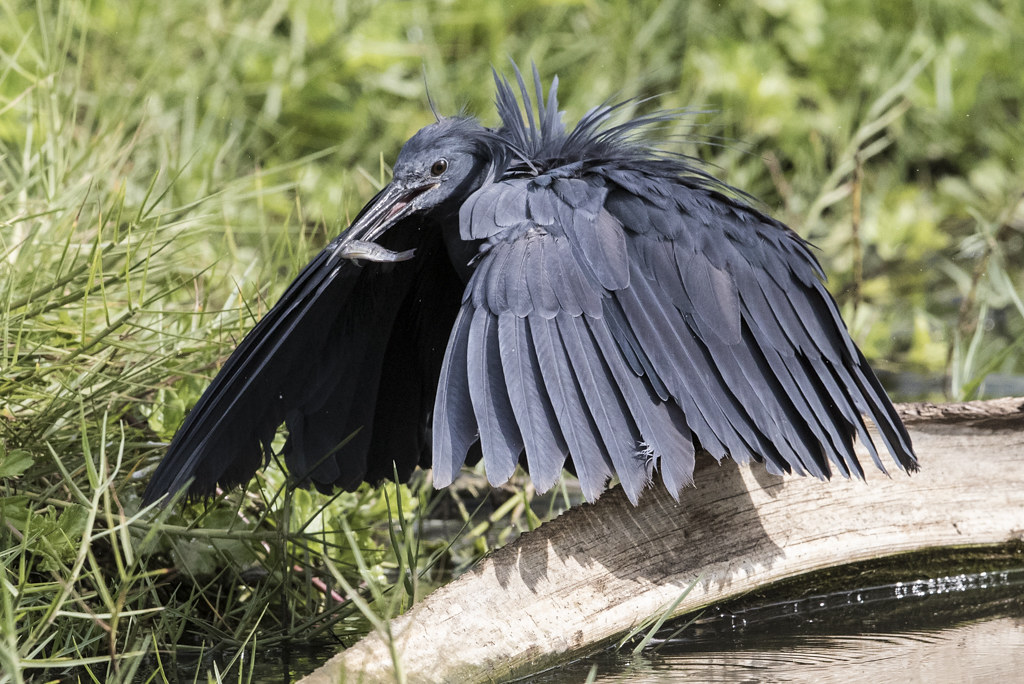
Even the grass seemed to hold fish.
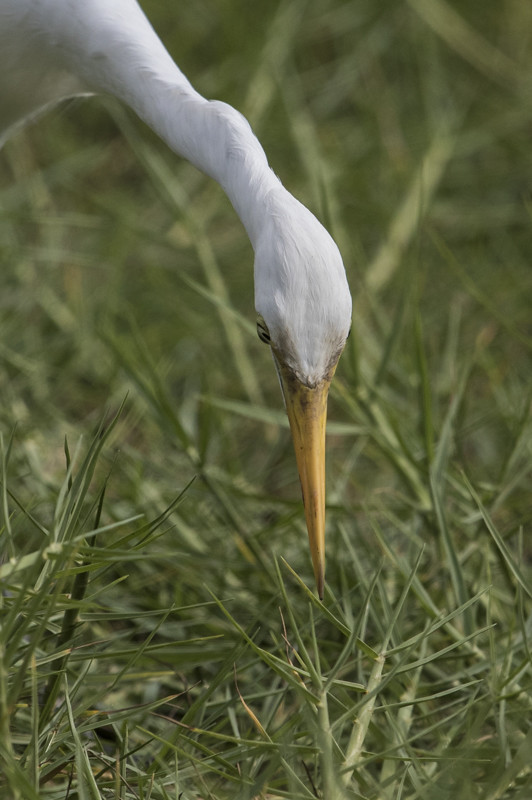
as this Intermediate Egret demonstrated!
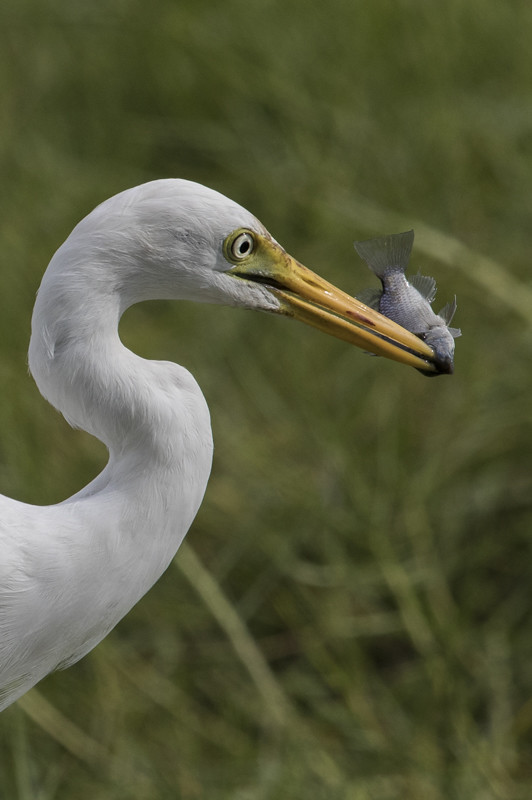
Even the Egret looks surprised but not nearly as much as I was when I saw the size of the fish the Hammerkop pulled out of the water.
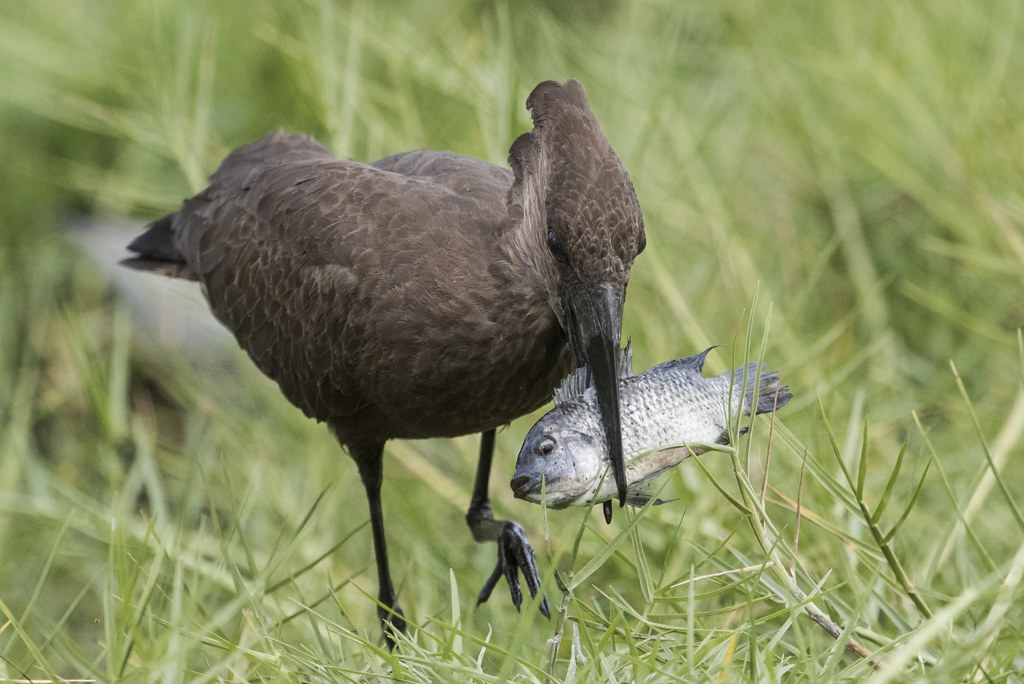
It took an age of trying.
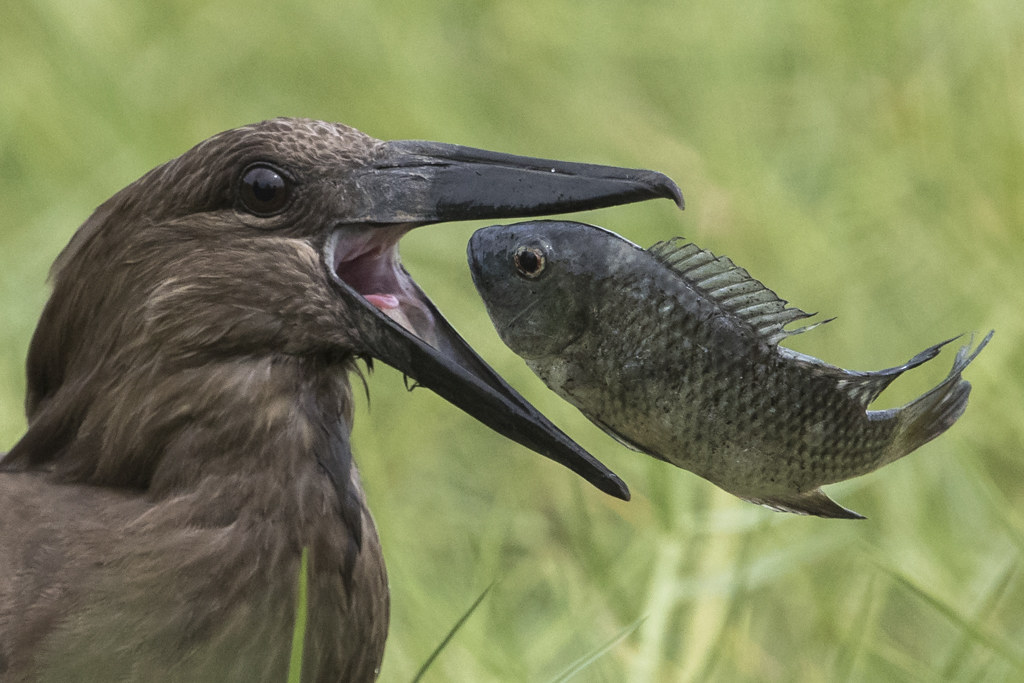
Juggling the fish this way and that before eventually after many attemptsd, managing to swallow the fish.
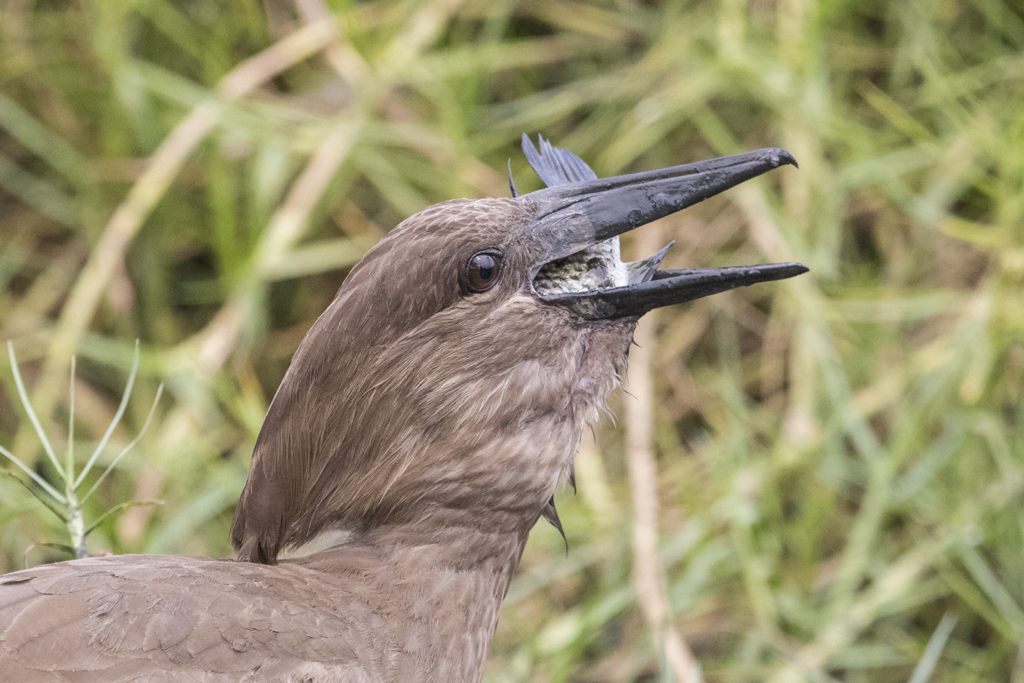
As the different species have different fishing methods all seem to tolerate each other's presence, however, two of the same species would often fall out. The Black Heron certainly didn't want competition but I guess two "Umbrella Birds" in the same pool really was pushing it for space.
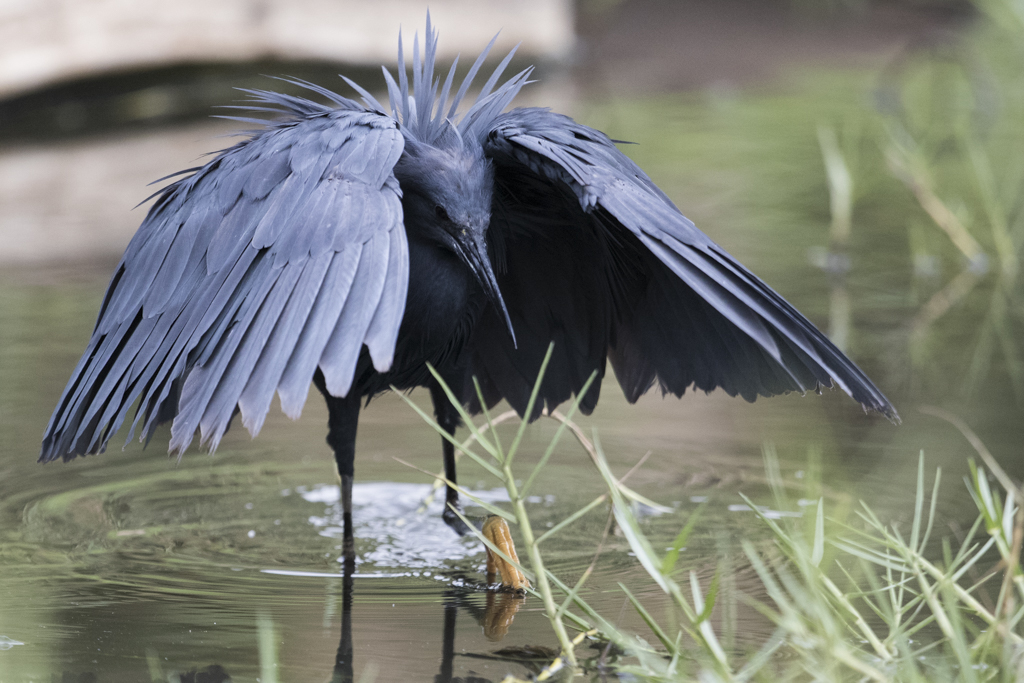
The one species that did command respect though was the Monitor Lizard. Everything kept out of this one's way.
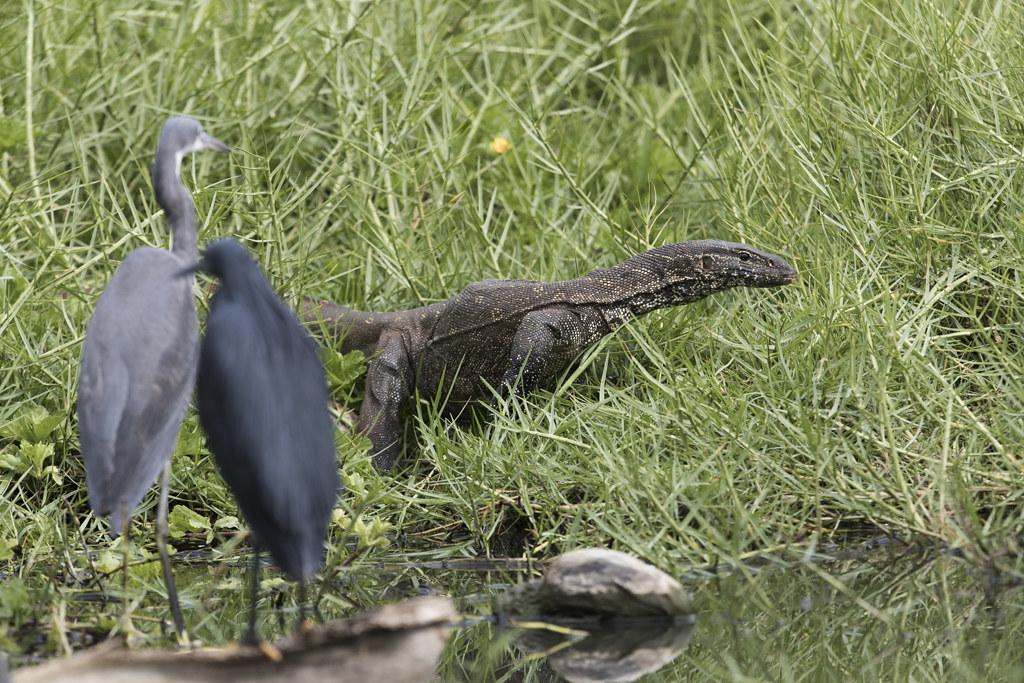
At one stage there were three in the vicinity albeit, two somewhat smaller than that big beast.
The pool kept me amused for a couple of days before sadly becoming fished out. Then it was back to scratching around for subjects. There might not be the action but the subjects and light were good enough.
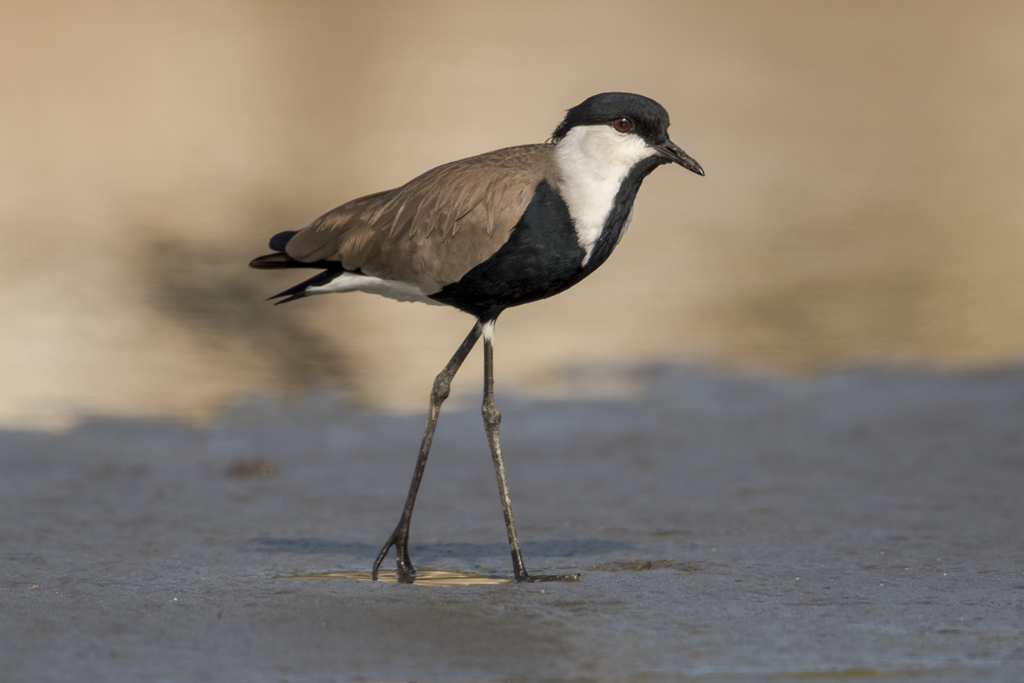
Spur-winged Plovers seem to get everywhere, on the beach, the local golf course, the rice fields.
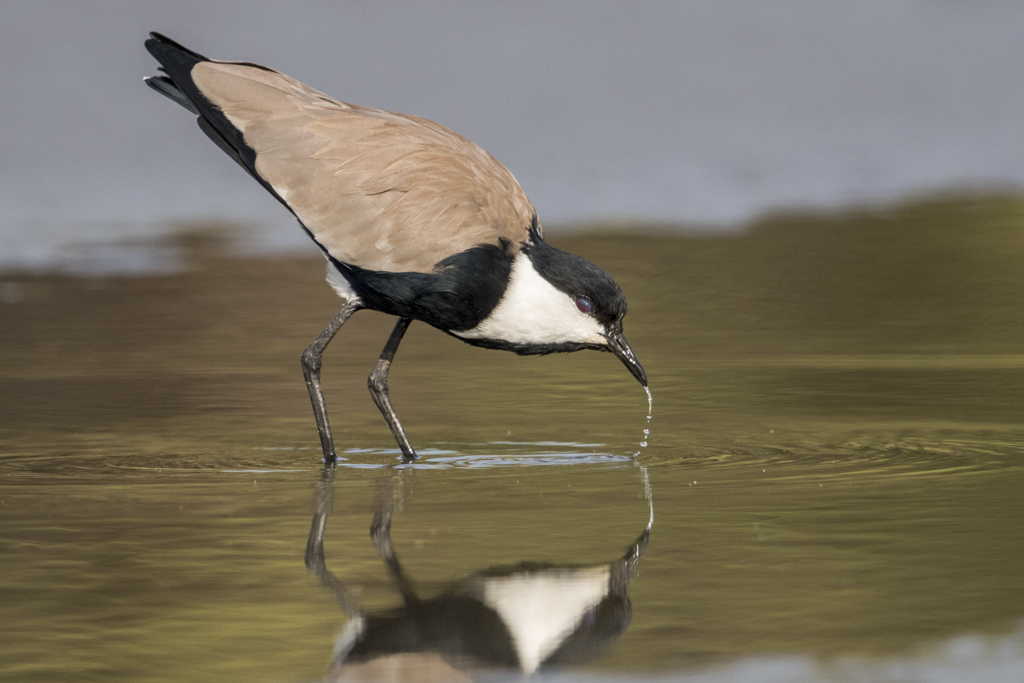
They can be a nuisance because they can kick-off if you approach carelessly, putting everything to flight. However, they are fine if you use caution.
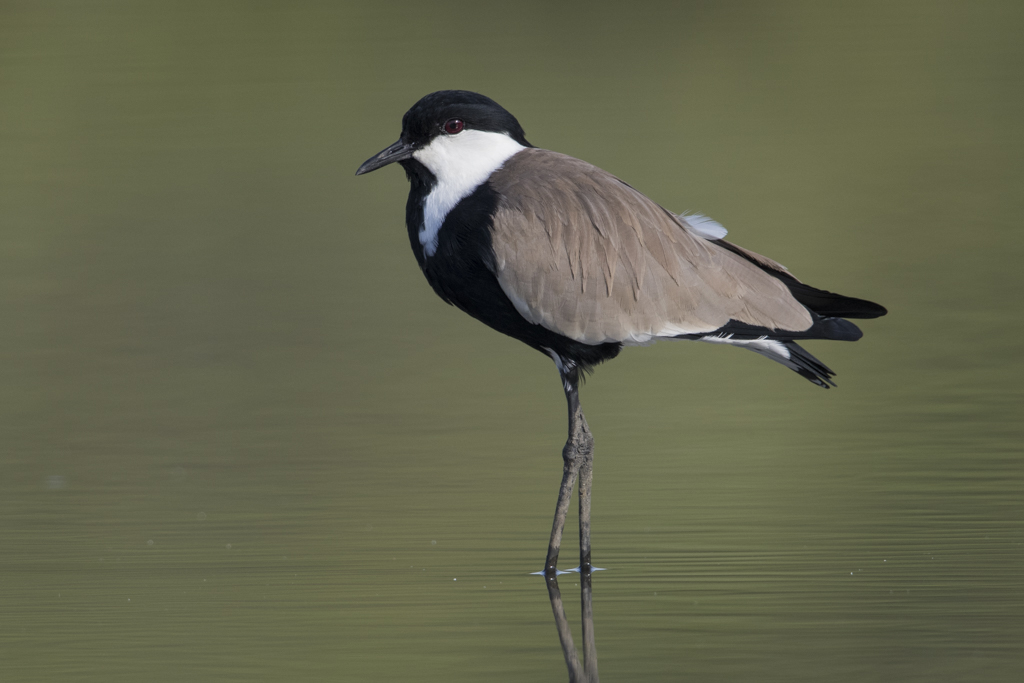
and can make a handsome portrait subject.
Wandering the golf course didn't seem to bring too much luck.This Yellow-wattled Lapwing is actually on the fairway, if you wandered in to the rough the grass is full of horrible tiny piked seed pods that are quite painful if you get them in your shoes.
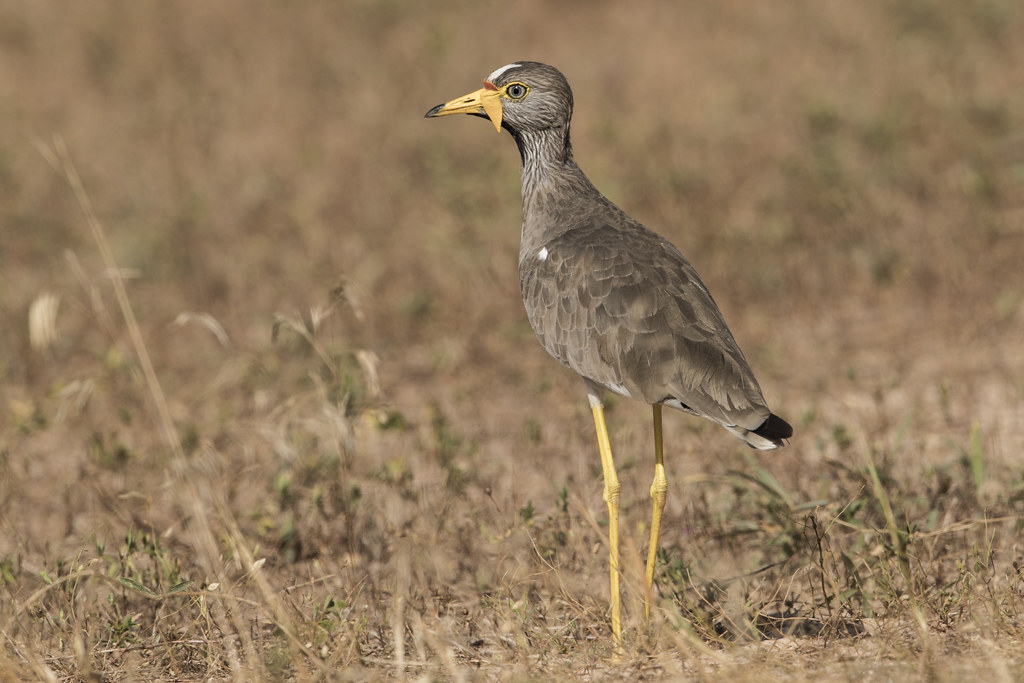
I didn't spend too much time there, besides, the variety was poor, the Cattle Egrets and Glossy Long-tailed Starlings being the only other regulars on the ground.
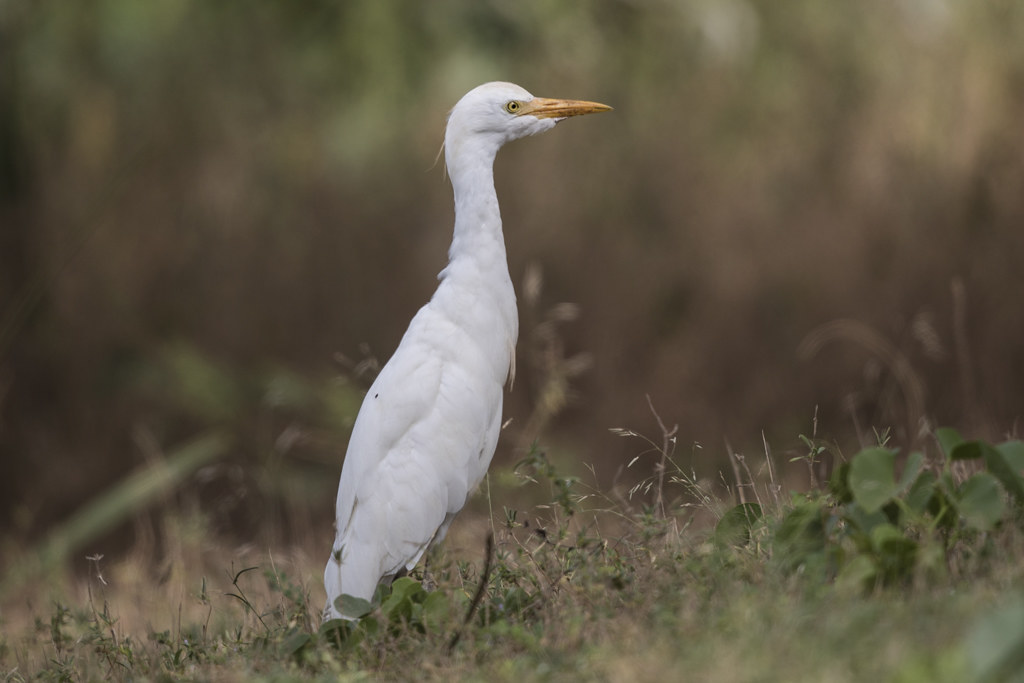
Consequently, the river estuary down by the beach had more appeal even if the birds lacked excitement.
.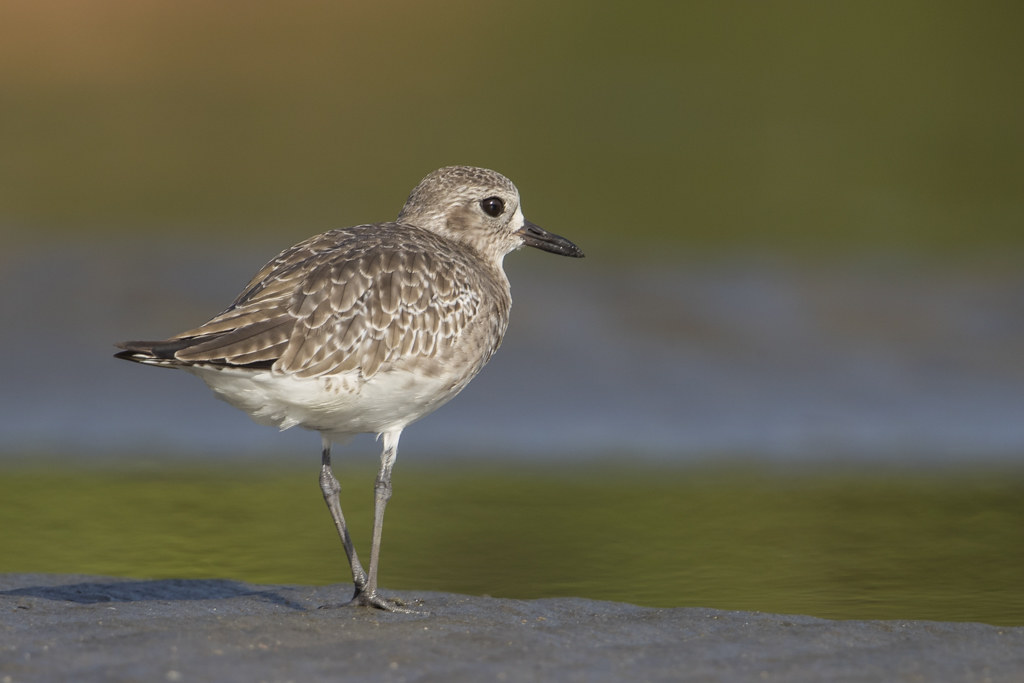
Grey Plover and Grey-headed Gull
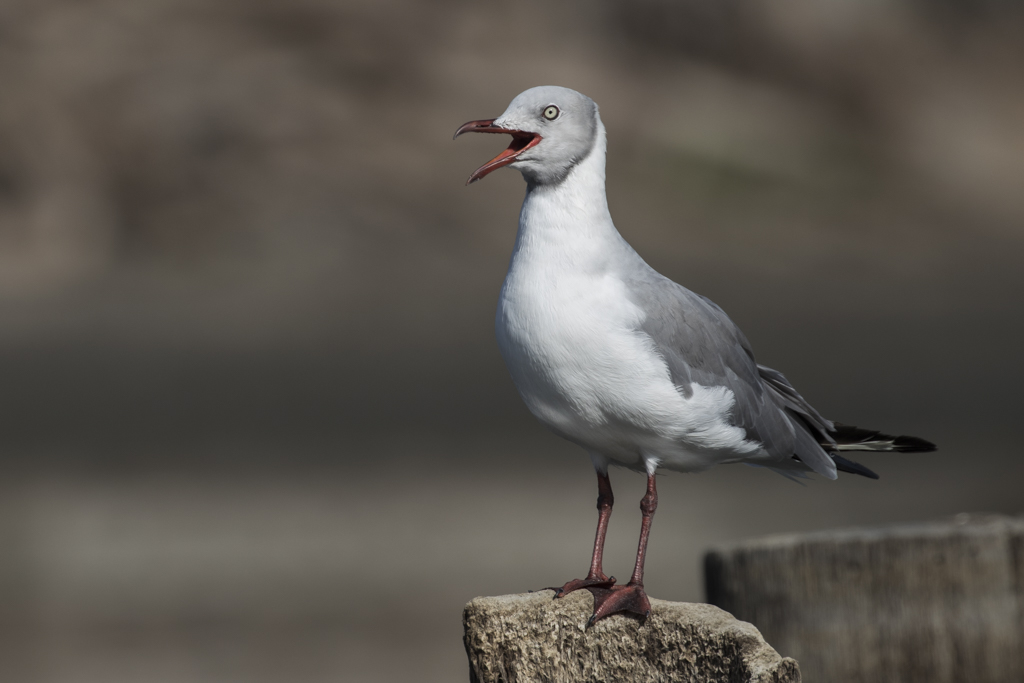
Long-tailed Cormorant was at least constantly grooming to give a variety of shots
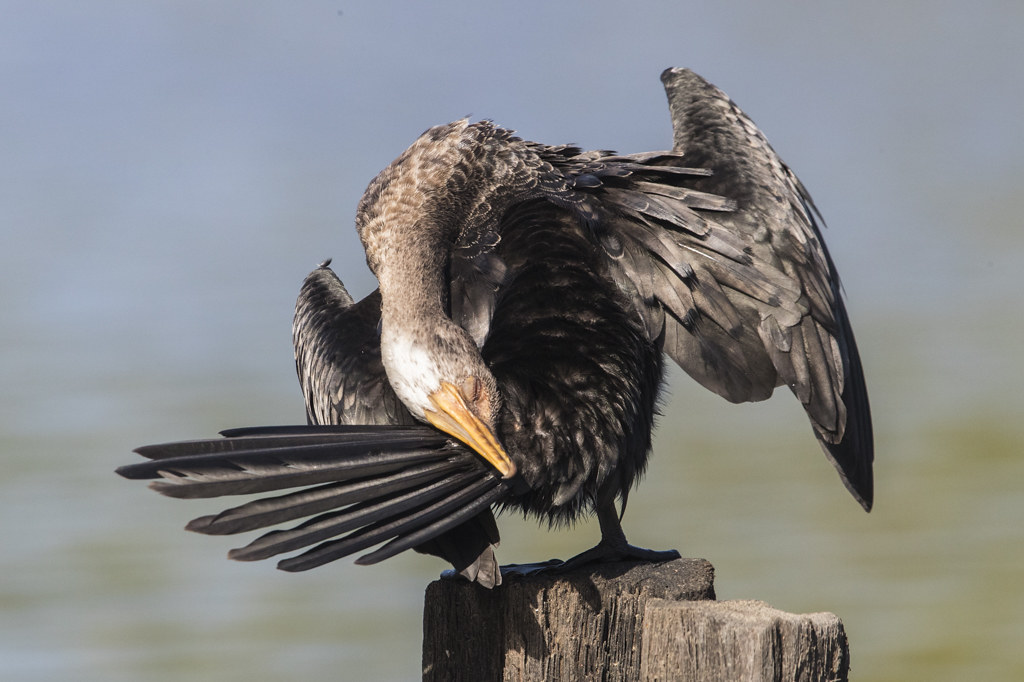
and the Whimbrel was a definite stand in when it went quiet.
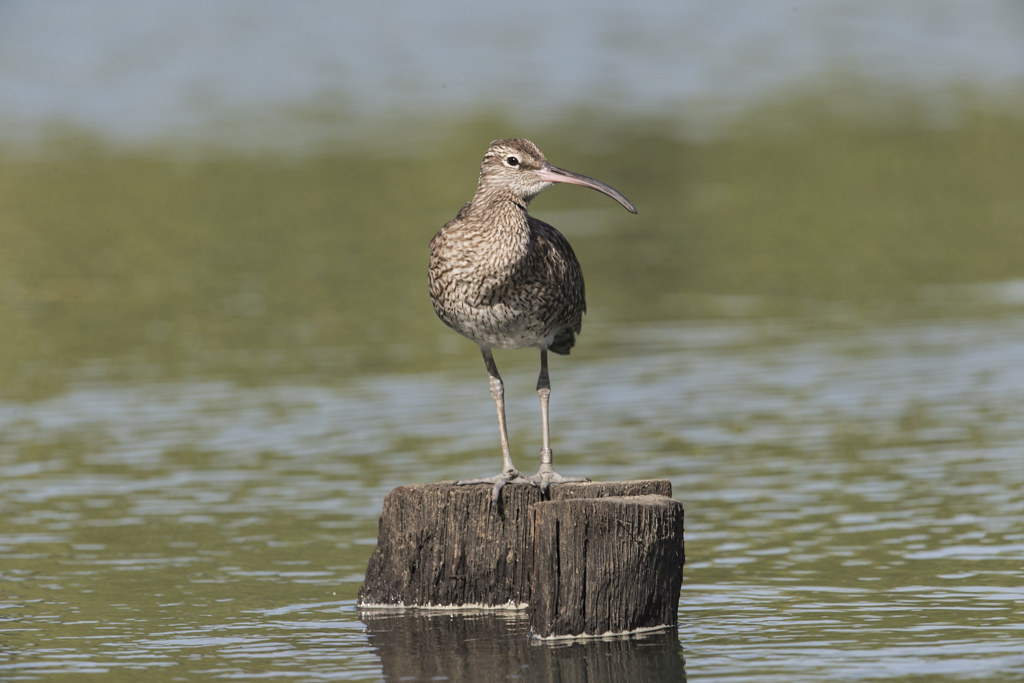
And sometimes it was so quiet even the Common Sandpiper appeared bored!
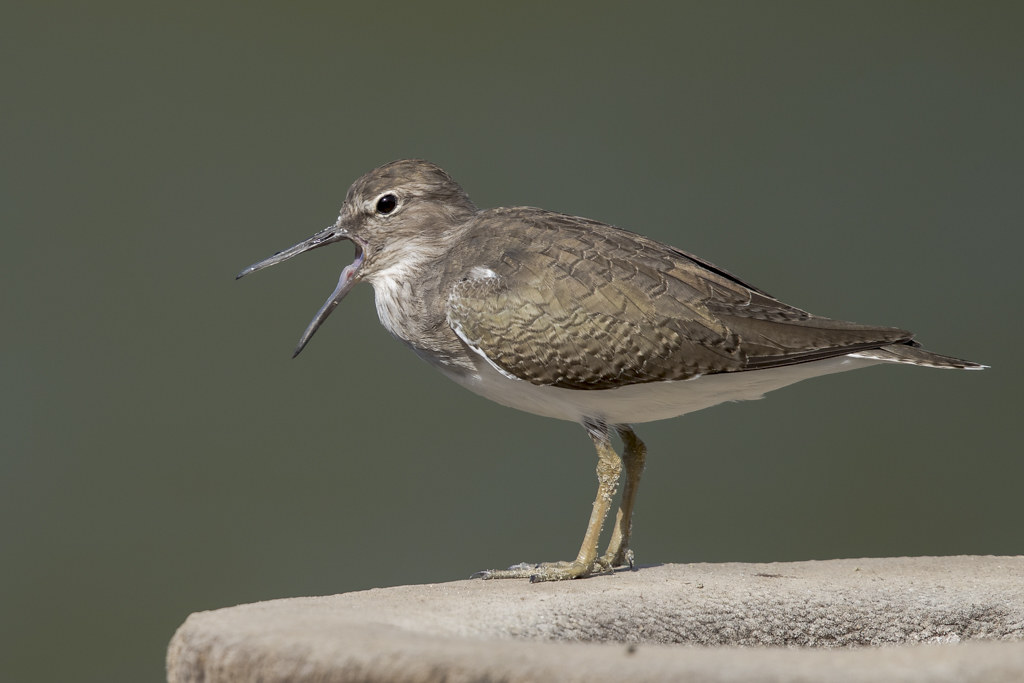
Would this keep me going for a whole two weeks though ?
TBC
I did have some slight doubts though. I had decided in advance that I would not be going to the extra expense of more guided trips, my budget was blown and this was a trip for Claire not me. The doubt was wether there was enough birding activity to keep me entertained for 2 weeks in and around the hotel. Lying by the pool all day is a non starter for me.
Fortunately I soon discovered a small pool, more a wet patch of ground really. Being near the river creek at Kotu this area floods during the wet season and as the flooding recedes it leaves behind one or two wet patches. I noticed that there was a huge amount of birding activity in this particular one which measured no more than a few square metres and was no more than ankle deep in water.
What was being pulled out was amazing! The fish were unbelievably big!

The Cormorant couldn't submerge fully and still caught a large fish. At least a dozen birds covering several species were sharing the same small space.
And every one was catching fish!

From Greenshank to Black Heron

Even the grass seemed to hold fish.

as this Intermediate Egret demonstrated!

Even the Egret looks surprised but not nearly as much as I was when I saw the size of the fish the Hammerkop pulled out of the water.

It took an age of trying.

Juggling the fish this way and that before eventually after many attemptsd, managing to swallow the fish.

As the different species have different fishing methods all seem to tolerate each other's presence, however, two of the same species would often fall out. The Black Heron certainly didn't want competition but I guess two "Umbrella Birds" in the same pool really was pushing it for space.

The one species that did command respect though was the Monitor Lizard. Everything kept out of this one's way.

At one stage there were three in the vicinity albeit, two somewhat smaller than that big beast.
The pool kept me amused for a couple of days before sadly becoming fished out. Then it was back to scratching around for subjects. There might not be the action but the subjects and light were good enough.

Spur-winged Plovers seem to get everywhere, on the beach, the local golf course, the rice fields.

They can be a nuisance because they can kick-off if you approach carelessly, putting everything to flight. However, they are fine if you use caution.

and can make a handsome portrait subject.
Wandering the golf course didn't seem to bring too much luck.This Yellow-wattled Lapwing is actually on the fairway, if you wandered in to the rough the grass is full of horrible tiny piked seed pods that are quite painful if you get them in your shoes.

I didn't spend too much time there, besides, the variety was poor, the Cattle Egrets and Glossy Long-tailed Starlings being the only other regulars on the ground.

Consequently, the river estuary down by the beach had more appeal even if the birds lacked excitement.
.

Grey Plover and Grey-headed Gull

Long-tailed Cormorant was at least constantly grooming to give a variety of shots

and the Whimbrel was a definite stand in when it went quiet.

And sometimes it was so quiet even the Common Sandpiper appeared bored!

Would this keep me going for a whole two weeks though ?
TBC
Subscribe to:
Comments (Atom)